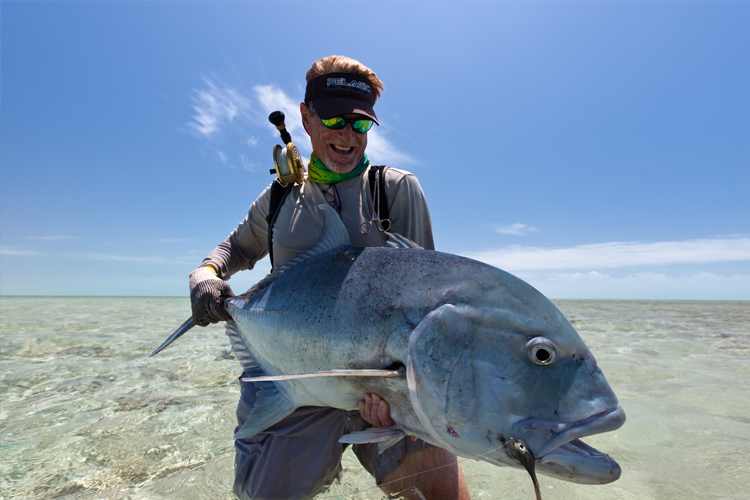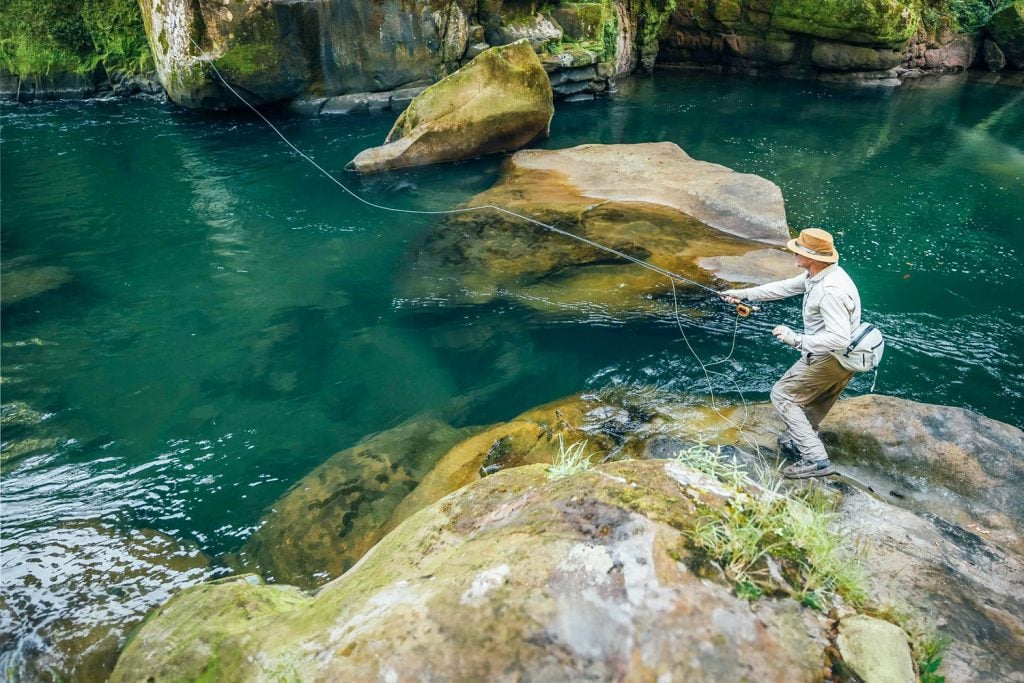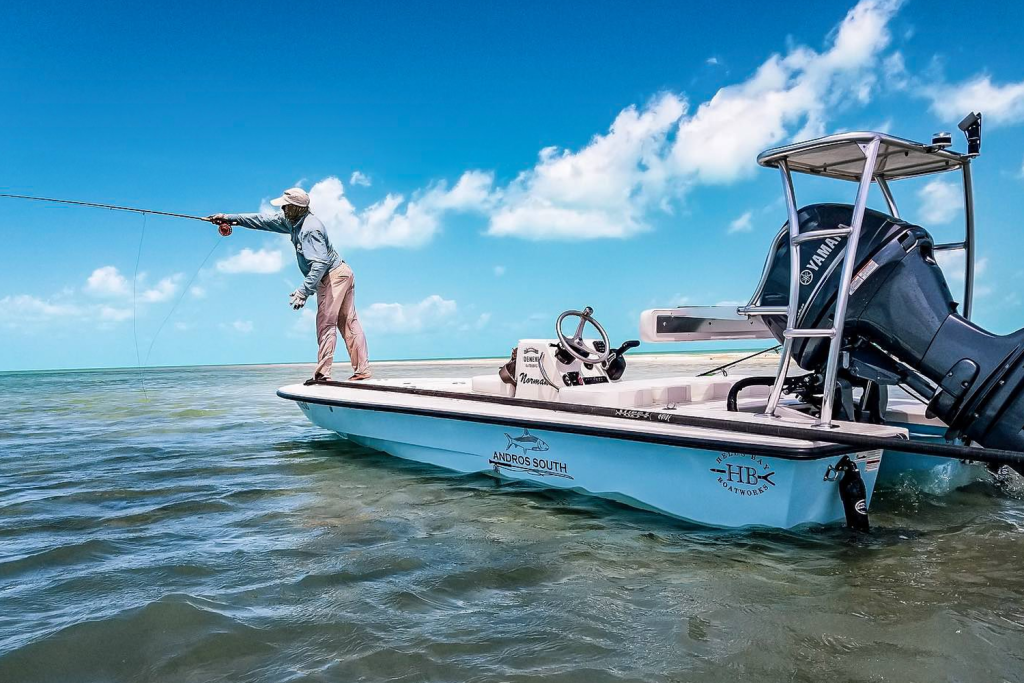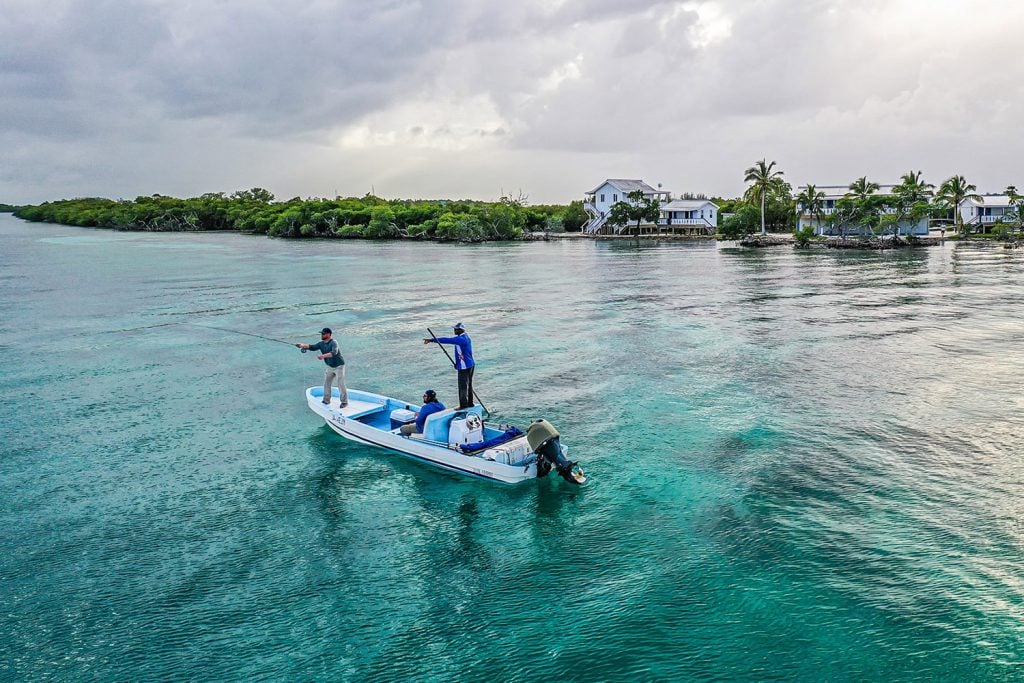Over the years, I have spoken to hundreds of customers about fly fishing for Giant Trevally and how to catch Giant Trevally, something many years ago everyone thought was crazy. As an all-around angler, I first encountered these fish big game fishing at the Andaman Islands. I then moved on to try another fishing method for them using poppers and jigs, which started to take off as a form of fishing in its own right. The popper fishing and jigging took us to places never fished before, and this style of fishing gave us an excellent understanding and experience of fishing for Giant Trevally. However, it was not long before we wondered what it would be like to hook and land these beats on fly fishing tackle.
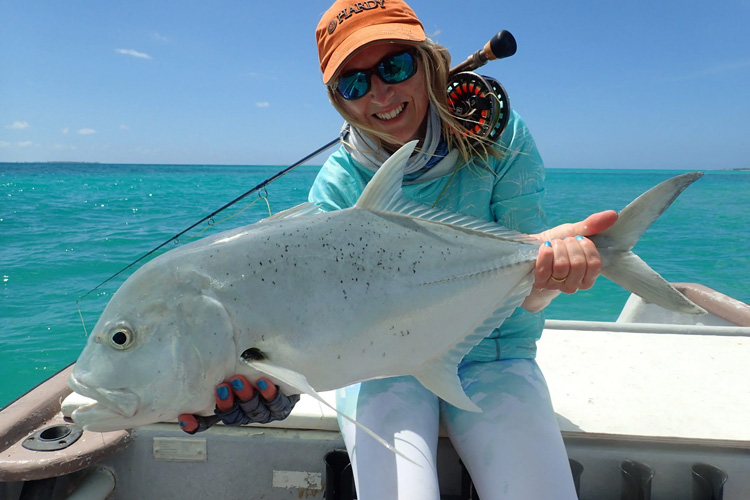

Our initial fishing method was a switch and tease; by taking the hooks off the poppers, we often found we could draw in GT’s close enough to cast a fly from the boat. It took a lot of experimenting to learn the proper techniques but the results were terrific, providing some great fights and essential insight into playing GT’s on a fly rod. However, it still never felt quite right as saltwater fly fishing to me always seemed like hunting, so casting out lures to tease fish back to the boat started to lose its appeal, which got us thinking more about how to catch Giant Trevally on the fly.
On my first-ever trip to the Christmas Island many years ago, fly fishing for these fish started to get under my skin. On this first trip, I saw GT’s come and hunt on the flats for the first time. Boy, oh boy, little did I know what a game-changer this was going to be.
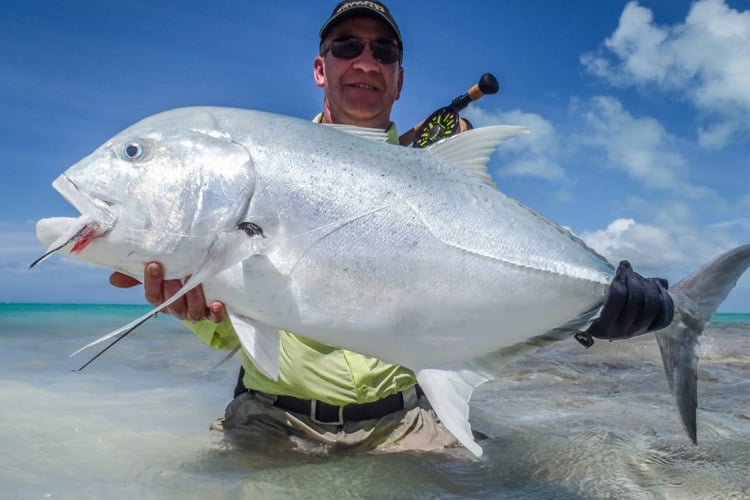

Now many years on, I still love targetting GT’s on the fly, as the thrill as they chase your fly until you have only the leader left from the rod tip gets your heart racing every single time.
Over the years, I have gained a lot of knowledge and experience fishing for these fish. Below I have shared some of the information I have learned about how to catch Giant Trevally, hoping that it also helps you be better prepared for your Giant Trevally adventures in hooking and landing more fish and so you can also learn how to catch Giant Trevally on the fly.
When Giant Trevally fishing, the old saying is “fail to prepare = prepare to fail”
If there is any weakness in your approach, tackle or methods, Mr GT will exploit it; he will chew you up, spit you out, turn around and give you a good soaking just for good measure.
How to catch Giant Trevally on the fly
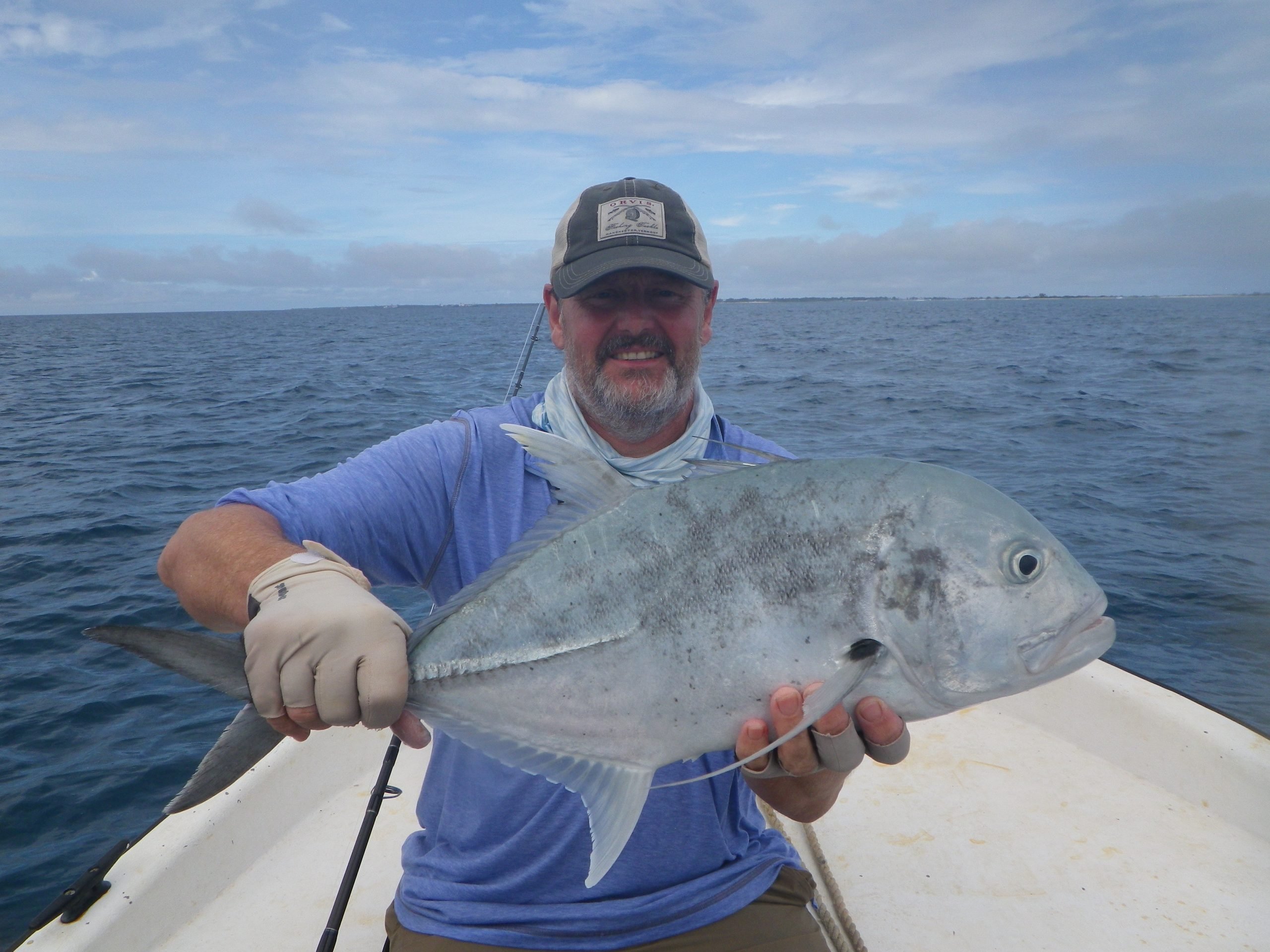

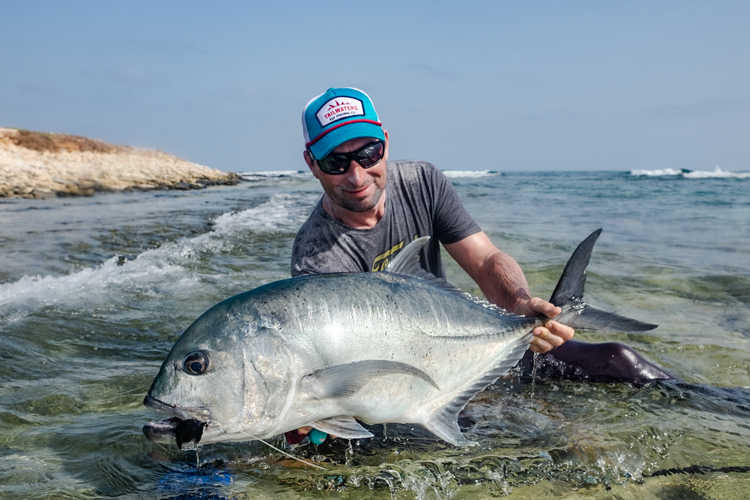

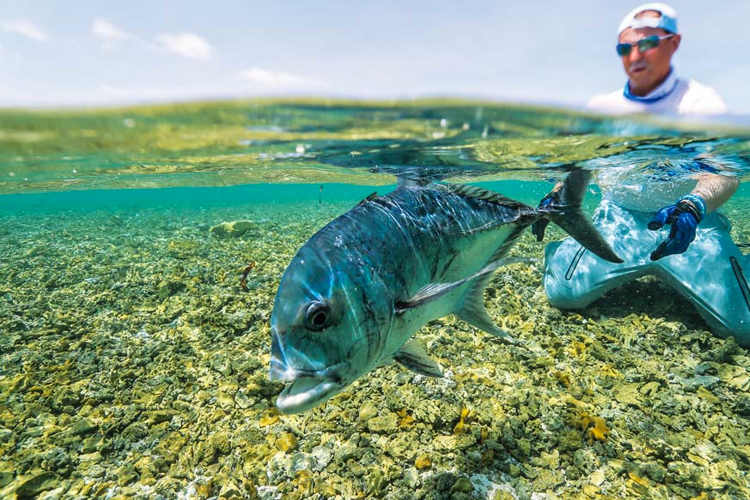

Mental Attitude to catch Giant trevally
Firstly you have to decide whether you are going on a trip to fish for just GT’s or going on a saltwater fly fishing trip to fish for all species.
Why do I say this?
Well, it has to do with your realistic expectations. If you are going to fish hard for GT’s and nothing else, you will always be in the zone and prepared as you will only be carrying one rod and will only concentrate wading in areas that you will find GT’s. If you’re not only casting at GT’s while on a saltwater fly fishing trip, you will not always be wading/fishing in the right areas that GT’S are found.
Sometimes, GTs only give you seconds of notice as they charge on a flat from a channel to only turn and charge back to deeper water. In that short period, you have to swap rods get out your line and make a cast. Do not get me wrong, I have caught some great GT’s fishing like this over the years, and still, today, if I am saltwater flats fishing and there are GT’s around, I will always have a 12# rod with me. However, if I have my serious Giant Trevally head-on, I will only take a 12# set up with me, as all I am going to look for and fish for are GT’s
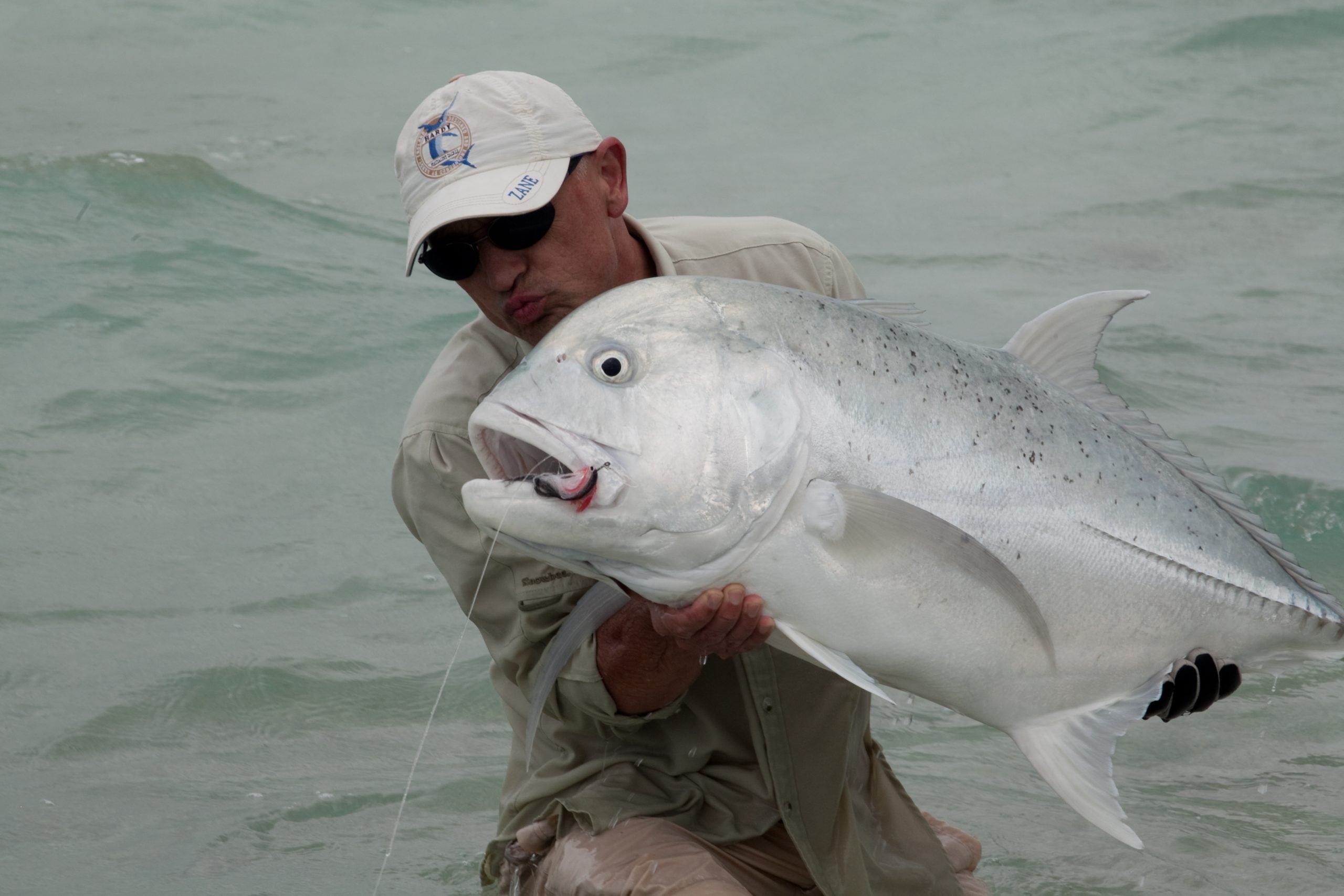

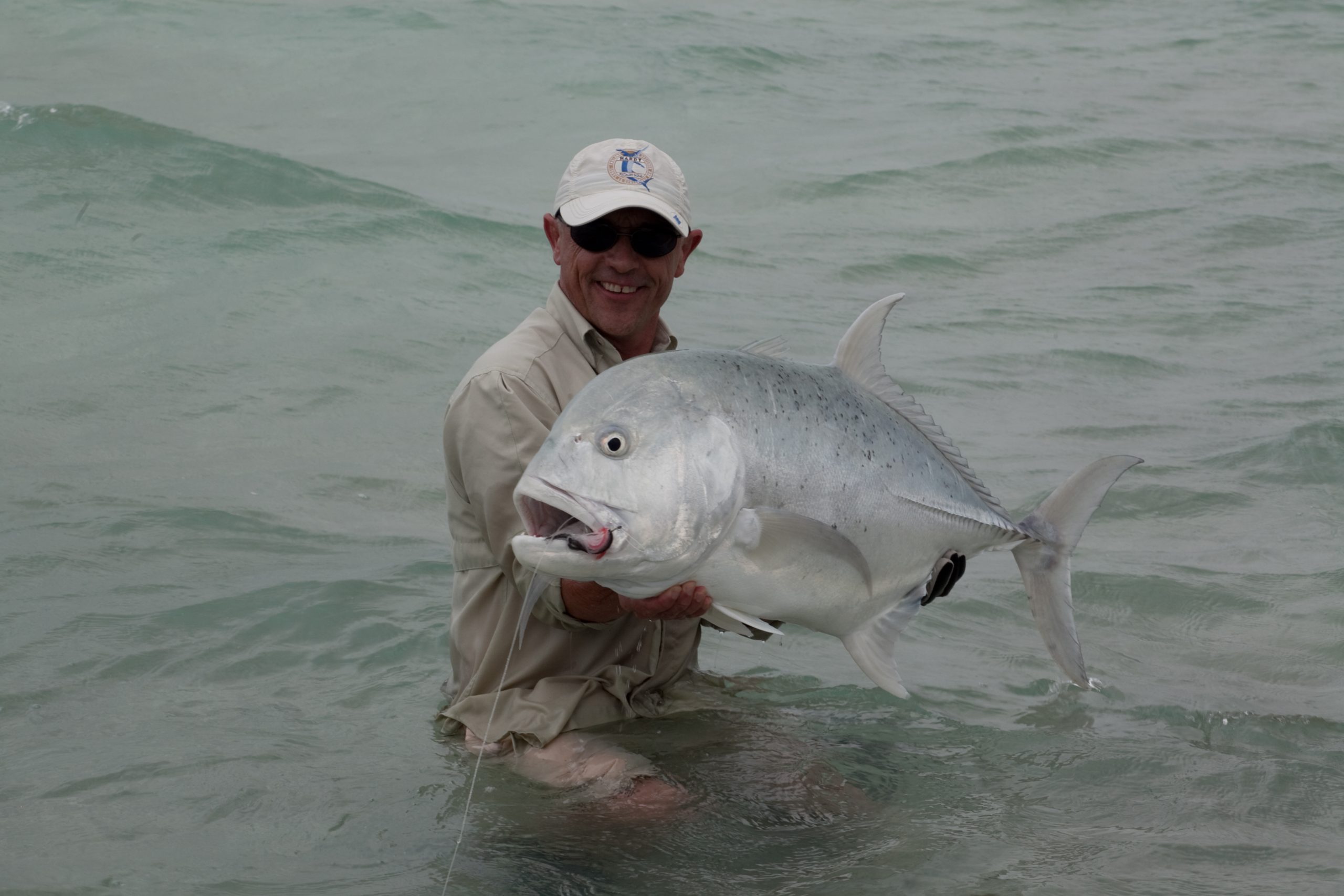

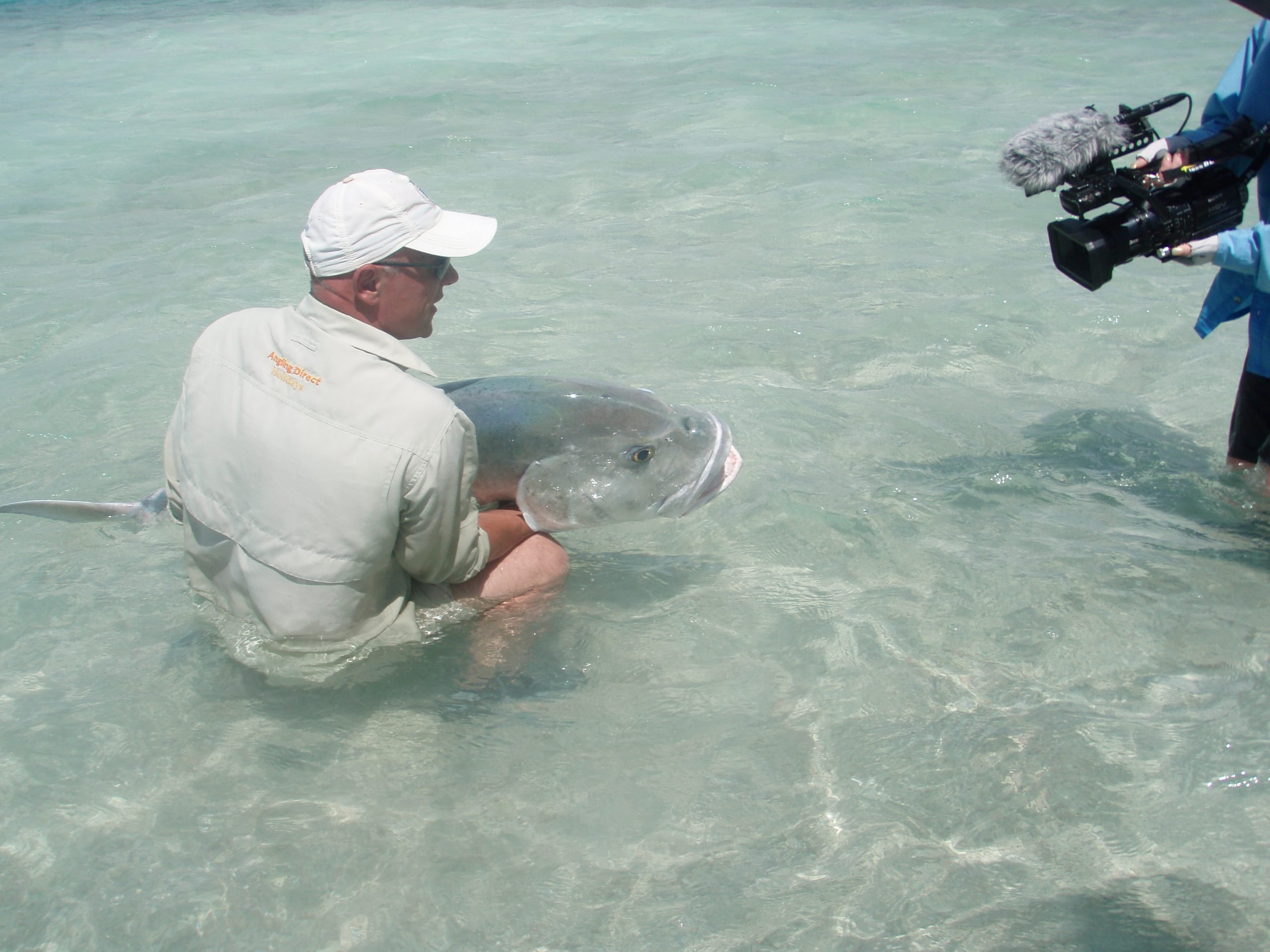

Realistic Expectations of catching giant trevally
Giant Trevally fly fishing in Christmas Island is not for everyone as wading all day with a 12# set up, along with flats, edges of deep channels, the steep shoreline or wading into the surf crashing into a reef are hard work. Add to this casting large flies, dealing with strong winds and hard fighting fish; it can and does take its toll.
If you come expecting 20 plus shots a day at GTs, this fishing style is probably not for you. If you are purely hunting GT’s, 2 to 4 casting shots a day is what you should realistically expect and is considered a good day. This depends on where you are fishing, but as an average, it’s a good guide.
Although Mr GT has the worse attitude of any fish, he will not just jump any fly presentation; even when you think you’ve got everything right, they often refuse at the very last moment. Even the best GT anglers still have days where nothing has gone right. Therefore we always believe that every Giant Trevally caught and landed on a fly is worth celebrating, for it is such an achievement.
The moral of the story is fly fishing for GT is not a numbers game; it’s all about the adrenaline. The hunt, the stalking, the presentation, the chase, the take, the screaming runs, the battles and eventually the capture.
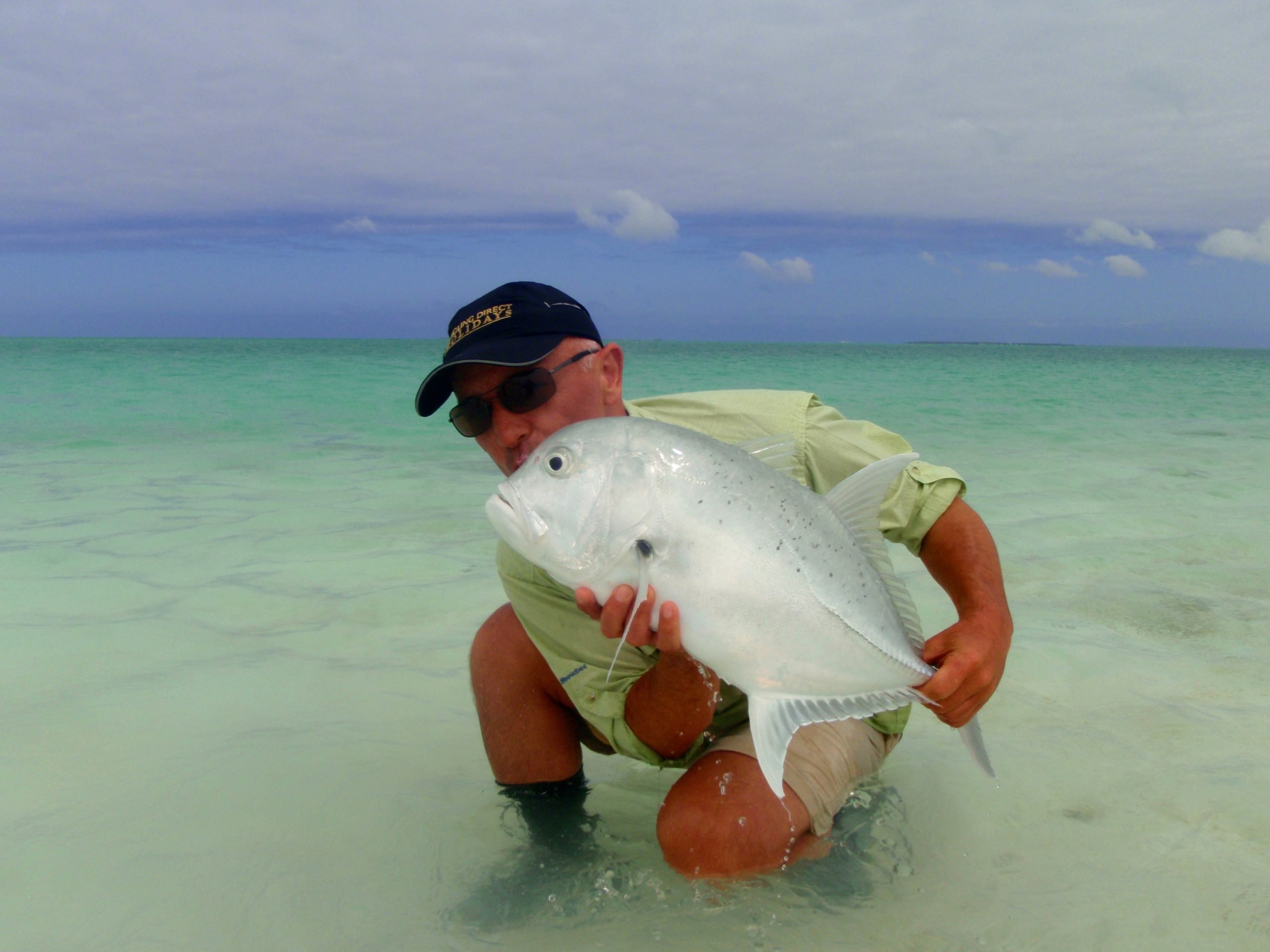

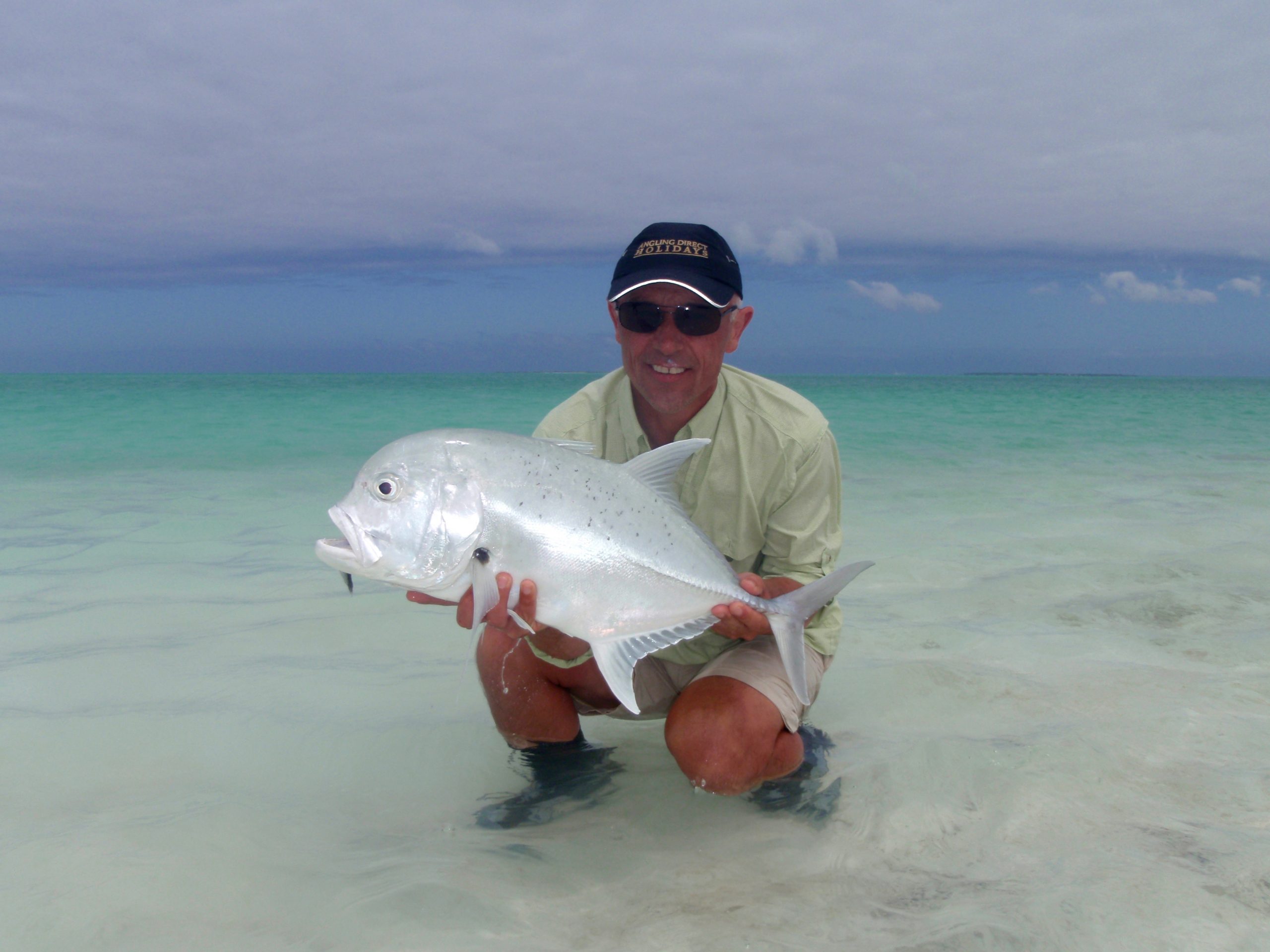

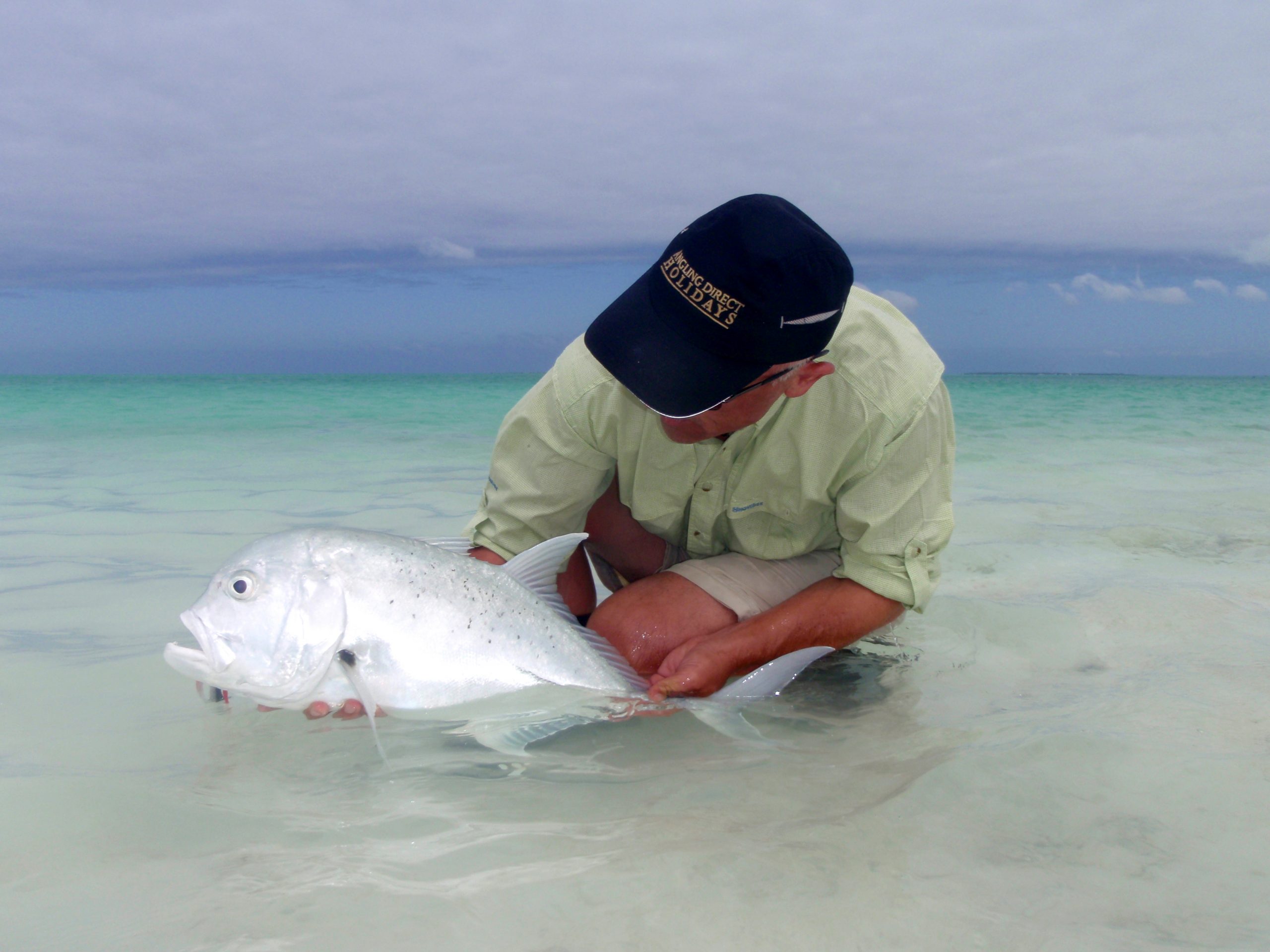

Tackle for catching giant trevally
As previously mentioned, if you show any weakness, then Mr GT will exploit it. Remember, fly fishing is an art form that not everyone can master. It takes skill, patience, determination and knowledge. Before you even think about how to catch Giant Trevally on the fly, you need to be very skilful with a fly in general. The right rod will also make it a lot easier to cast large flies and have the power to land your catch.
Use 12# fly rods to target Giant Trevally as they have both the power to cast large flies and enough strength in the but section to land these beasts. To match, you need a high-quality large arbour saltwater reel with a robust and smooth drag. Load your reels with three hundred yards of 80lb braid and, most of the time, a tropical fly line rated for Giant Trevally fishing. I prefer the one that has an 80lb braided core running through it. I have often played a GT only to see when I am reeling in, parts of my fly line hanging off like a piece of spaghetti. If I weren’t using a line with an 80lb braided core, these would be lost fish. Believe me, if a GT gets close to the coral you need everything in your favour.
Good GT fly rods also have to have a good balance of power; you need flexibility in the top section of the rod to cast a line and large flies. You also need extreme power in the butt section to give you the ability to hold and pull fish away from the structure. The more modern travel fast action fly rods make such a difference in this type of fishing. I use the Scot Mackenzie Grafine range of rods as they have never let me down.
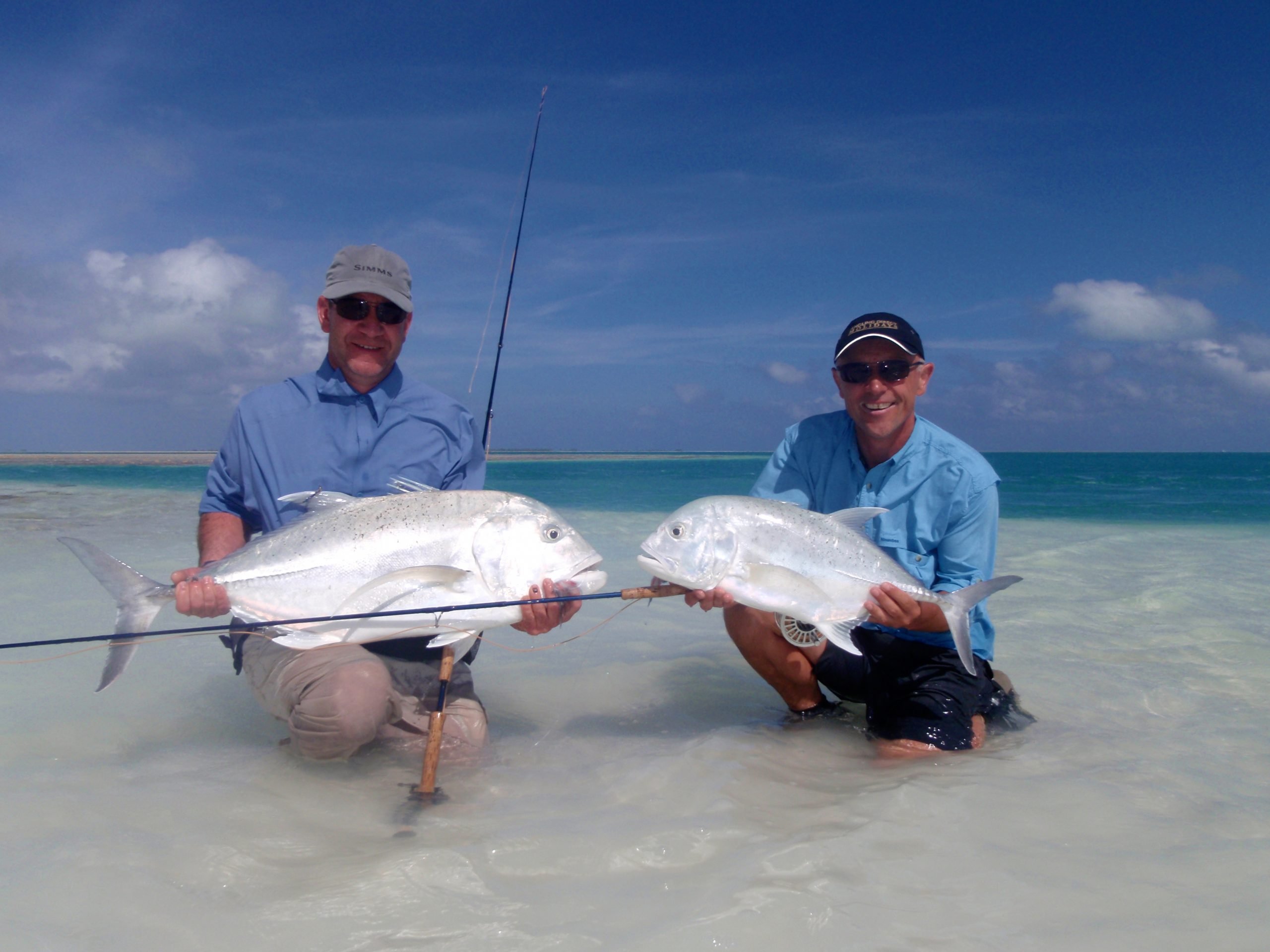

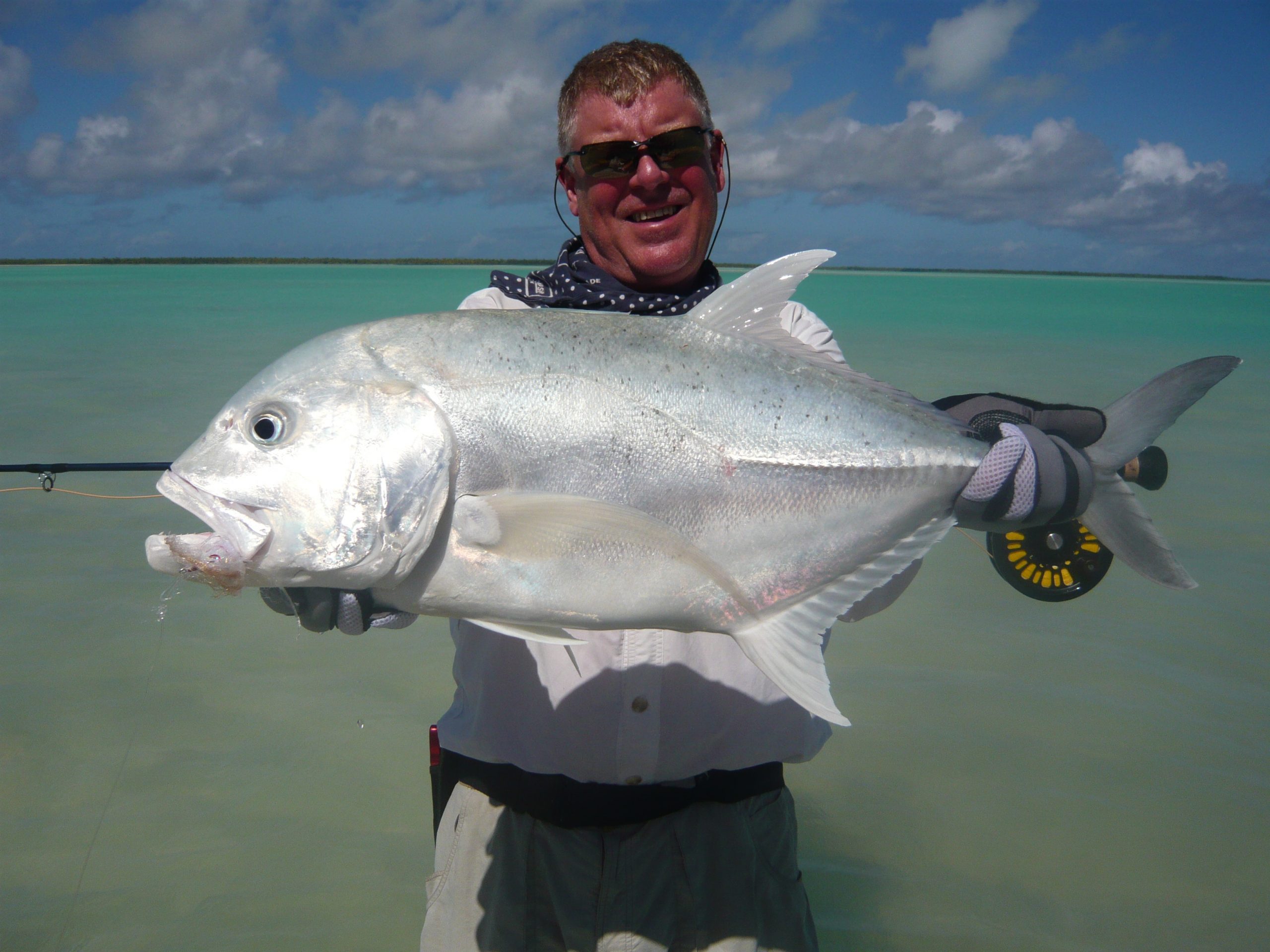

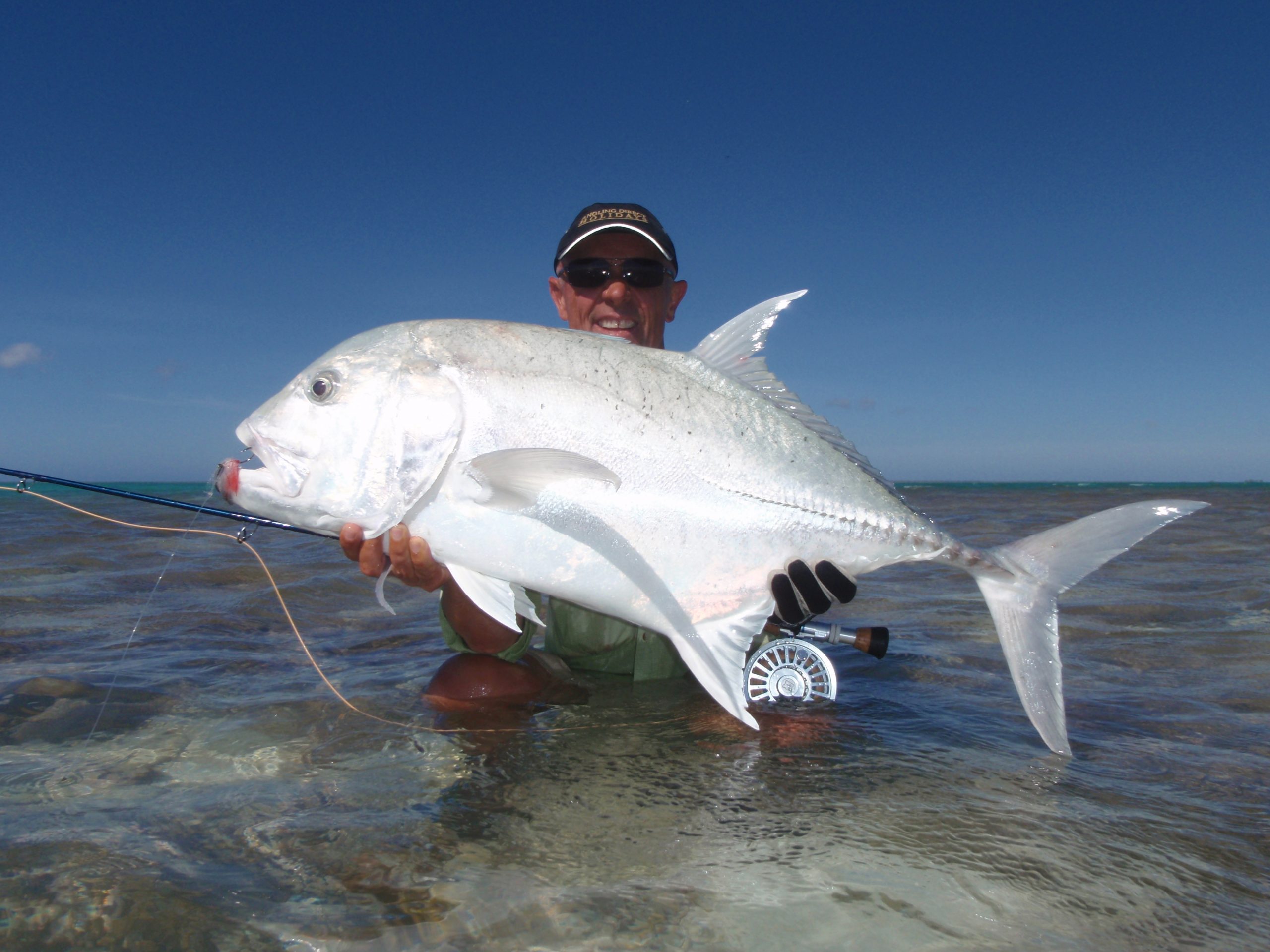

Best Tides For GT’S
I believe and have for a very long time that the best tide for GT’s is an incoming tide. GT’s like an incoming tide onto the flats as they know that there will be plenty of water following them and that they will not get stranded. Also, on an incoming tide, the cool freshwater flows onto the shallow flats, and many invertebrates such as crab, shrimp and worms leave their holes. This brings Bonefish and other small fish onto the flats to feed, and the chain continues up to the bigger predatory fish like the Giant Trevally.
On an outgoing tide, especially as the tide is getting very low and shallow on the flats, there are always some low points, sometimes only 12 inches deeper than the surrounding flat, which acts as small channels draining the water off the flats. If you find these places, it is always good to stand at the end of them where they empty into a deeper channel as GT’s know that all the baitfish that have left things late will be coming off the flats down these channels. It can be a bit like a drive-in restaurant for GT’s, so it’s always a good place to stand and cast flies.
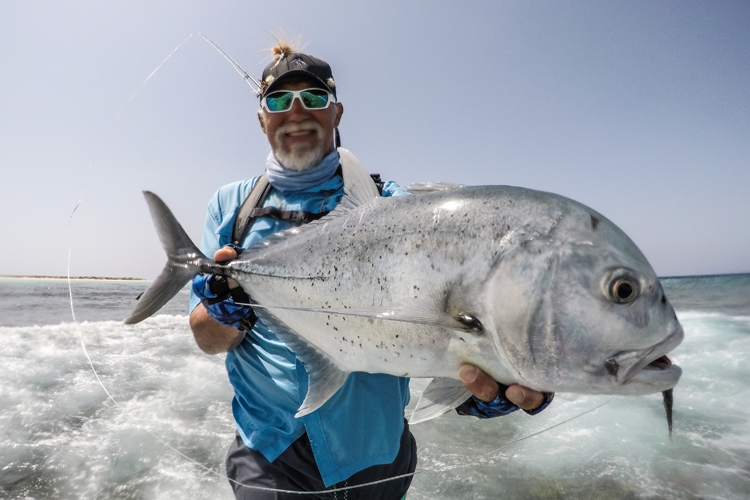

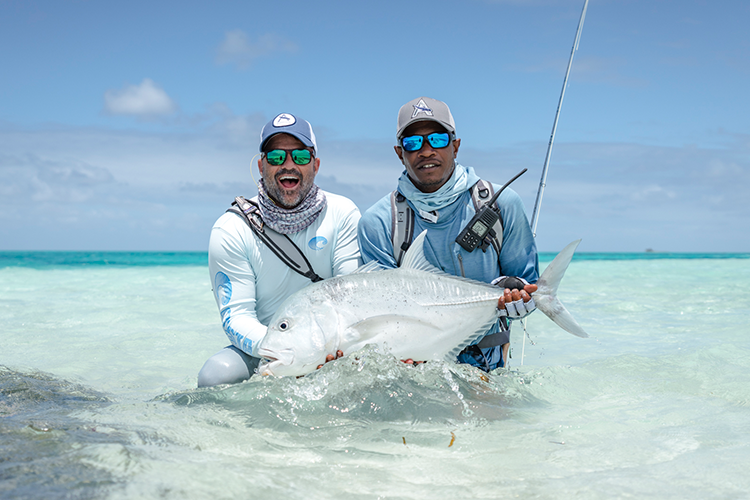

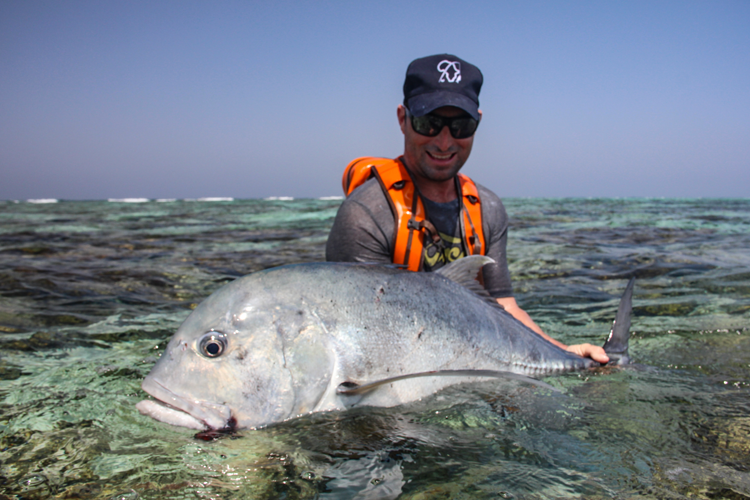

Best Moon Phases For GT’S
The Moon phase also affects tides as on both a new moon and a full moon, you get a spring tide, which is the most substantial tide. These bigger spring tides allow the Giant Trevally to access areas that they cannot normally do on a neap tide as the water level will be much higher.
I have personally found on big spring tides, it brings more GT’s from the deeper water to hunt on the shallow flats and therefore gives the angler more opportunities. If I had to pick just one time to fish, for me, it would always be on a new moon; in other words, no moon. The reasoning is quite simple; a new moon brings spring tides and good water; however, no moon means GT’s cannot hunt at night. If you look closely at a GT, you will see they have large black eyes, perfectly designed for seeing prey in low light conditions like moonlight. This gives GT’s an advantage in hunting and feeding in low light when the prey struggles to see them coming. Therefore on moonless nights, GT’s will not be feeding, so come morning, all the GT’s you encounter will be aggressive and super hungry.
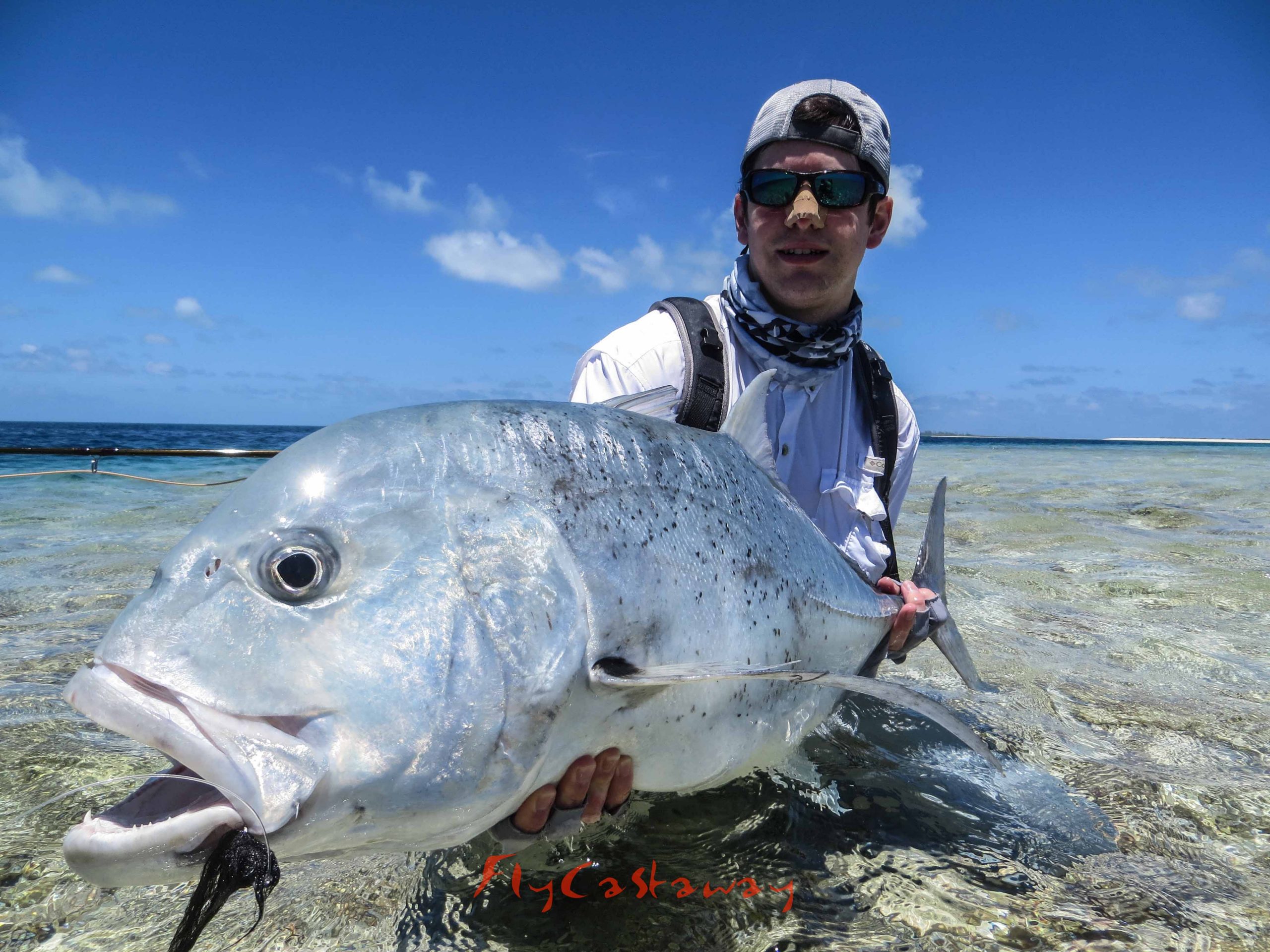

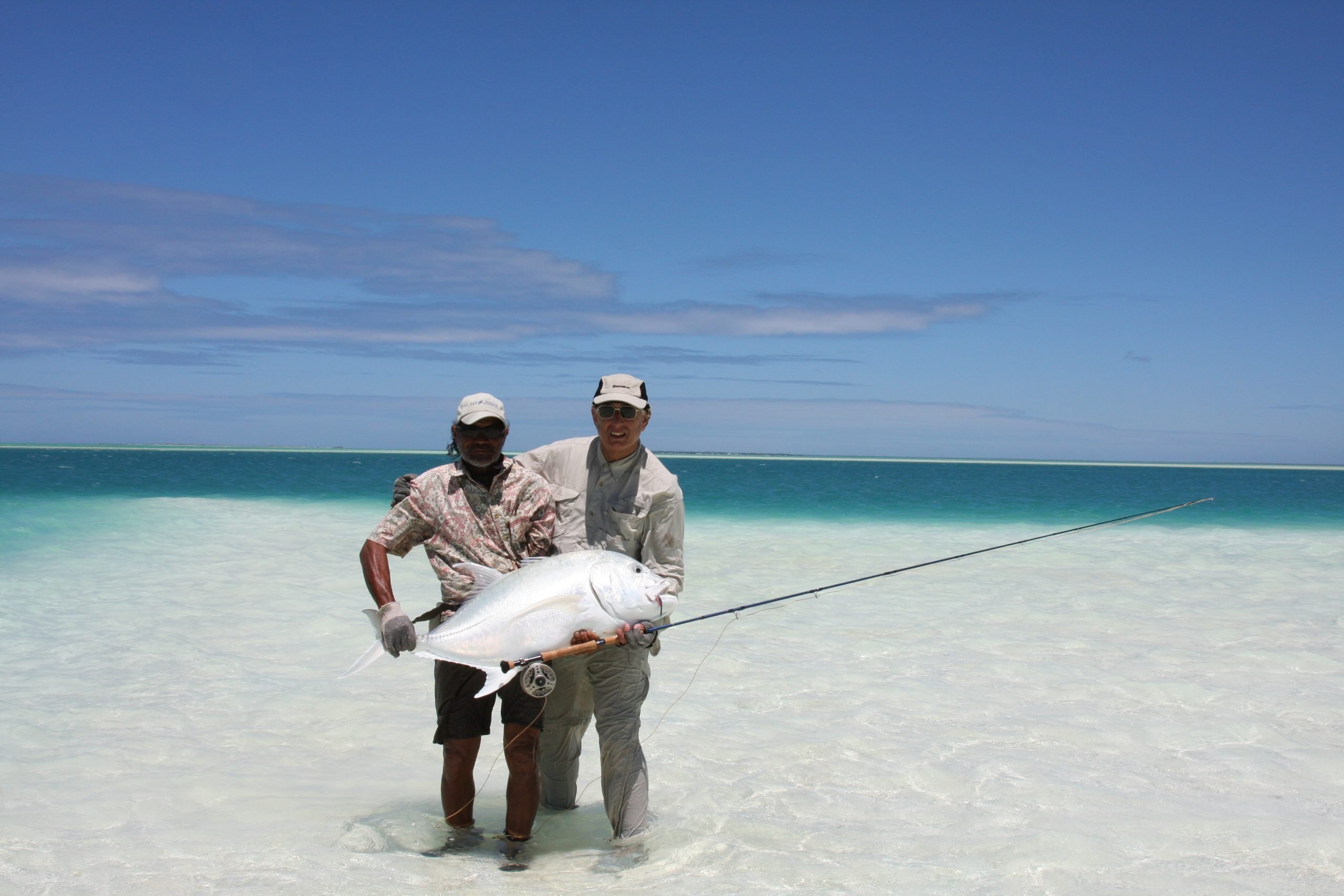

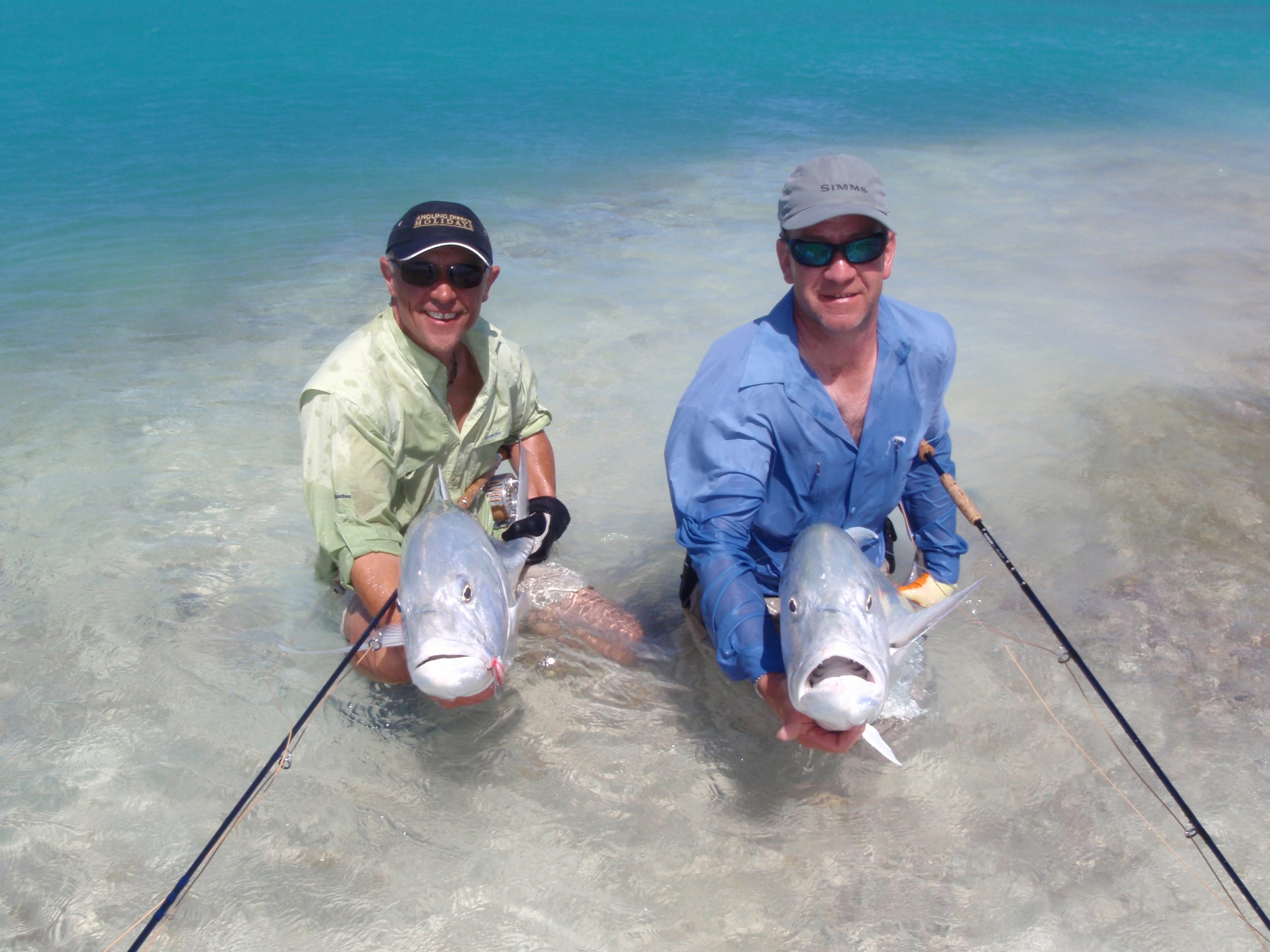

Casting for giant trevally
If I can refer you to the beginning, fishing for GT’s is all about being prepared. I always advise customers unless they have lots of experience casting 12# rods with big flies, to take some lessons.If you think you are up to it, go and find some water or even a park field and practice. If you feel you have mastered it, then go back on a windy day, try to cast with the wind on your back and try with the wind on your side. If you are right-handed, try and cast with the wind pushing into your right shoulder (make sure you have a significant fly but take off the point of the hook). You will soon realise that you will hit yourself if you do not know how to fish effectively with the wind on your side. Additionally, try casting directly into the wind and even backcasting. All this practice will only help when all the action happens.
The next thing to practice is wading and being ready to cast so that you can react fast, and I mean fast! Sometimes you fall lucky, and you get to spot Mr GT swimming along, making his way down to you, so you have all the time in the word to get ready. However, most times you spot Mr GT, you have to wade or even run to intercept them while getting out the line and casting a fly.
The trick is easy; ALWAYS have the line stripped off the reel. Have the coils of different lengths hanging from your casting hand fingertips. Hold the end of the loops in your left hand with as much of the D loop hanging from your rod. I always have my fly lightly hooked in my cork.
You are now armed and dangerous, so when you spot a fish, you throw the end of the line in your left hand out to the left while at the same time allowing the coils to fall from your fingers. This now means all your casting line is around your feet in the water, tangle-free. Unhook your fly, throw it forward while rolling your rod, so you make a forward roll cast; as you lift the rod to start to make your cast, the rod will load quicker as you will be raising a line from the water. One or two false casts is all you should need.
For more information on this technique, read our blog called “tips on managing your running line.“.
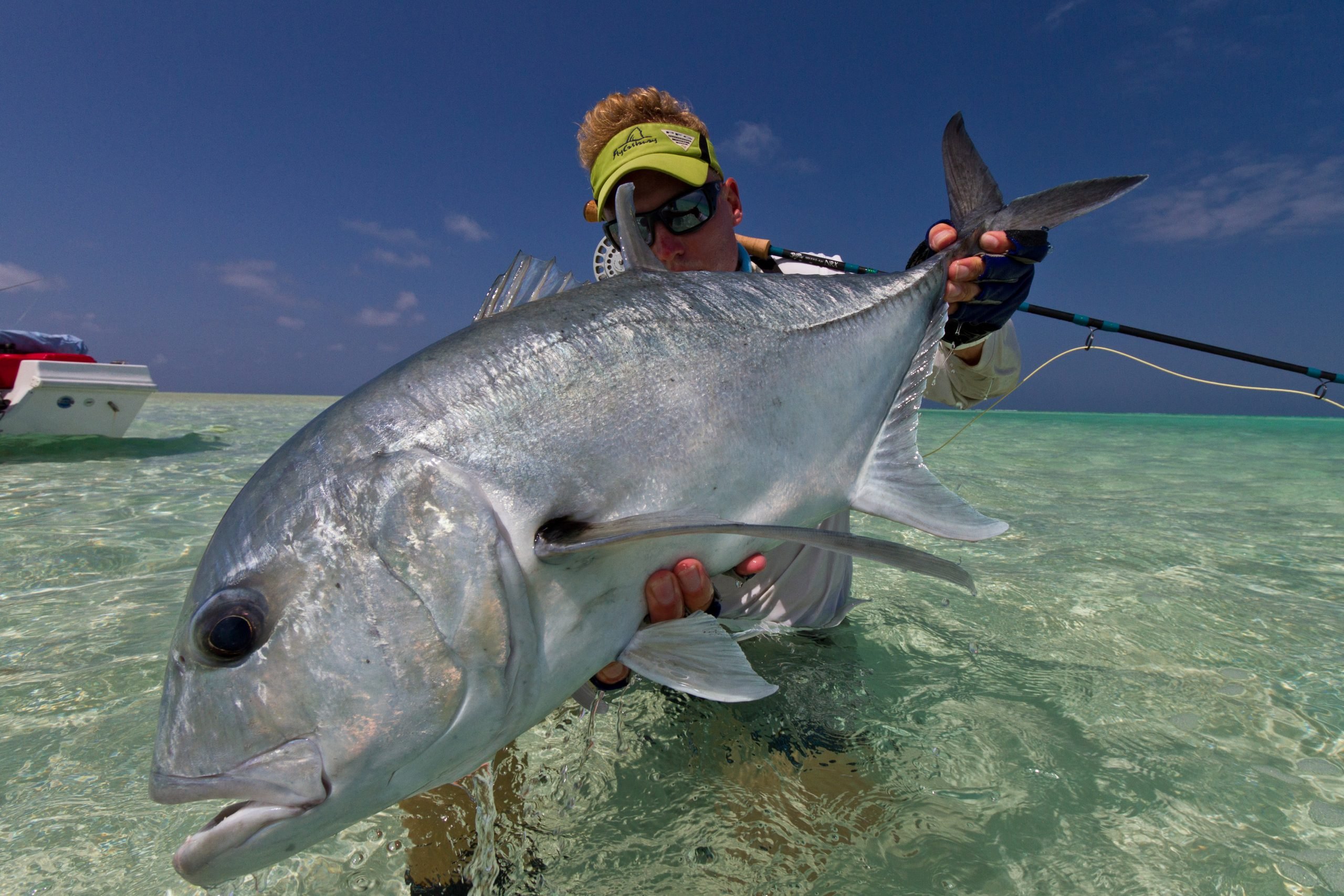

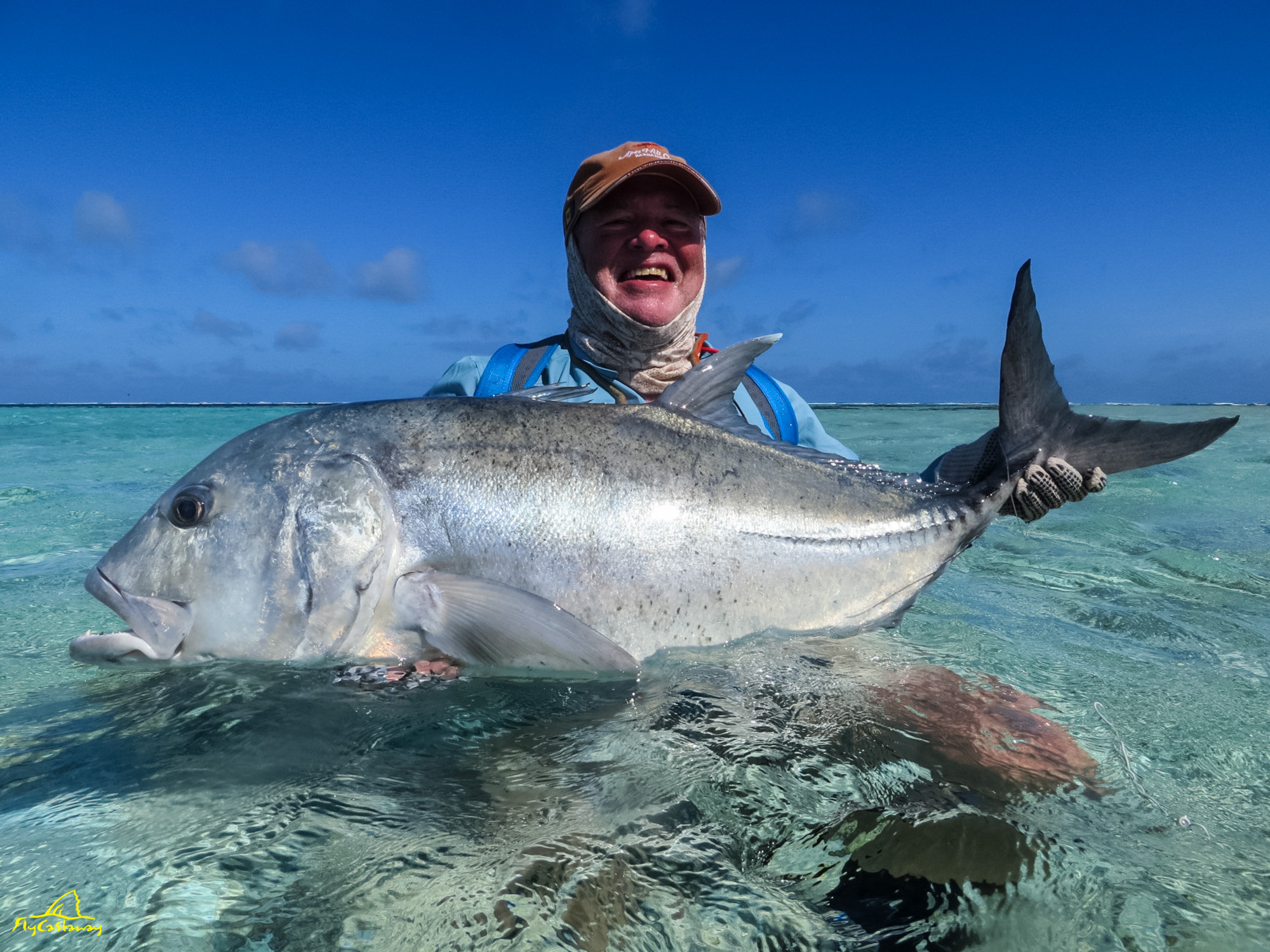

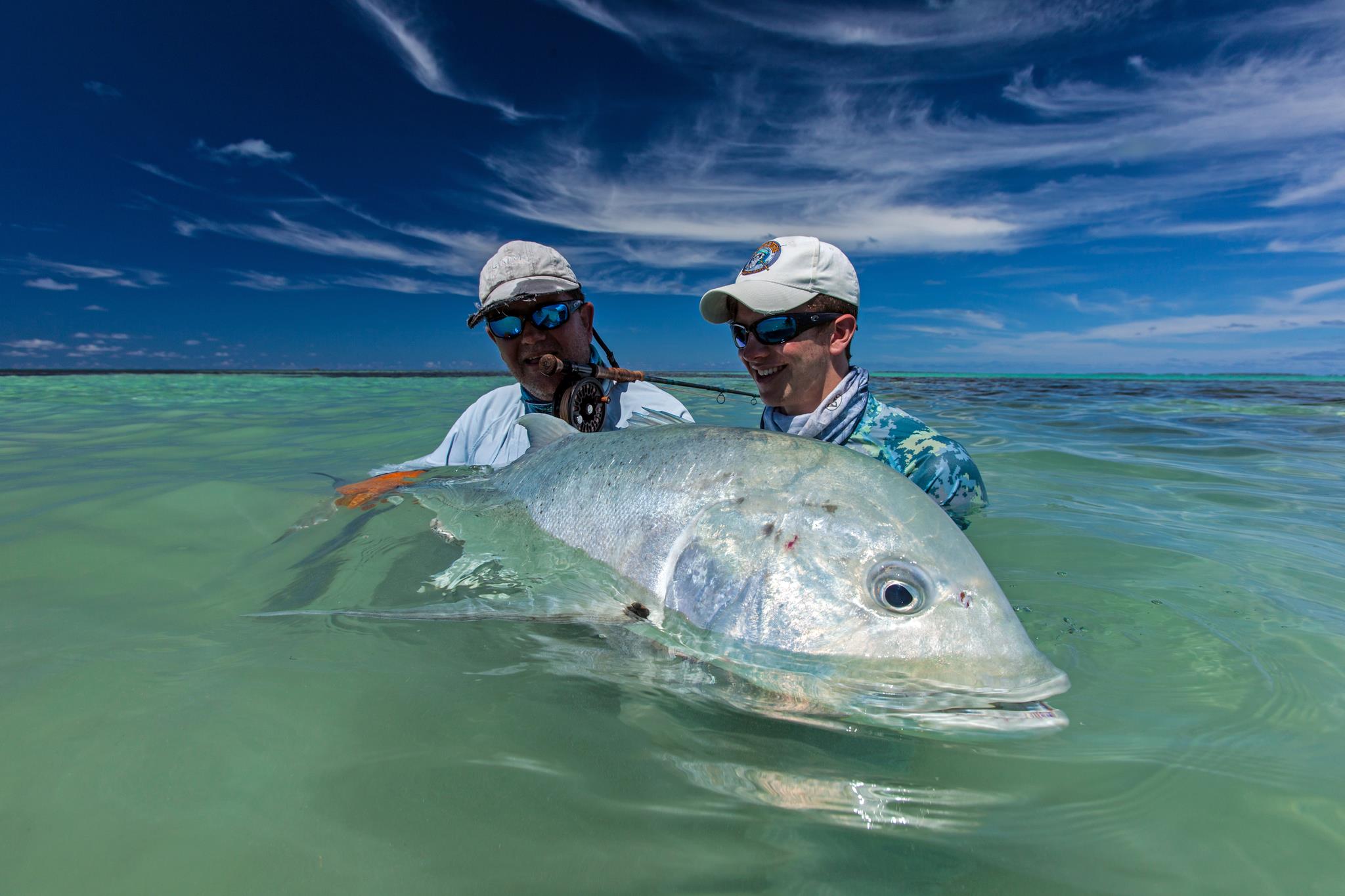

giant trevally fishing – Listen To Your Guide
When you spot a Giant, Trevally, it is crucial to remain calm, which is a lot easier said than done. Listen to your guide and move into position quickly whilst trying not to make too much noise. When your guide calls for you to make the cast try and lead the fish by 3 -4 rod lengths, this is a good rule of thumb. GT is aggressive, but if the fly lands on the head or behind the GT, the chances of the GT hitting the fly are almost none.
Once the fly has is presented, you need to start a long and fast retrieve. I always teach my customers that you have to strip like you do not want the GT to grab your fly. Treat it as a competition; try as hard as you can not to let him eat it, and then 90% of the time, he will. If you get too excited as it gets closer, don’t slow up as you want the GT to eat your fly; if you do, he will turn away as no baitfish as a GT chases it will ever slow down as it swims for its life. The GT may be aggressive but is no fool.
When a Giant, Trevally, eats your fly, keep the rod tip pointing down and pointing at the fish. You will have to set the hook with what is called a strip strike. As you are stripping, you will have the rod in your right hand and the line you are stripping in your left hand. As the Giant Trevally eats the fly, hold on tight to BOTH the rod and the running line in your left hand, simultaneously pull as hard as you can with both hands while pointing the rod at the fish. 2 or 3 sharp pulls as hard as you can (you will not snap off) backwards with both hands will be enough to set that hook. Once the hook is in, you can release your hold on the line in your left hand. Once all the spare line around your feet has run out, and the line is now pouring off the reel, you can now lift the rod.
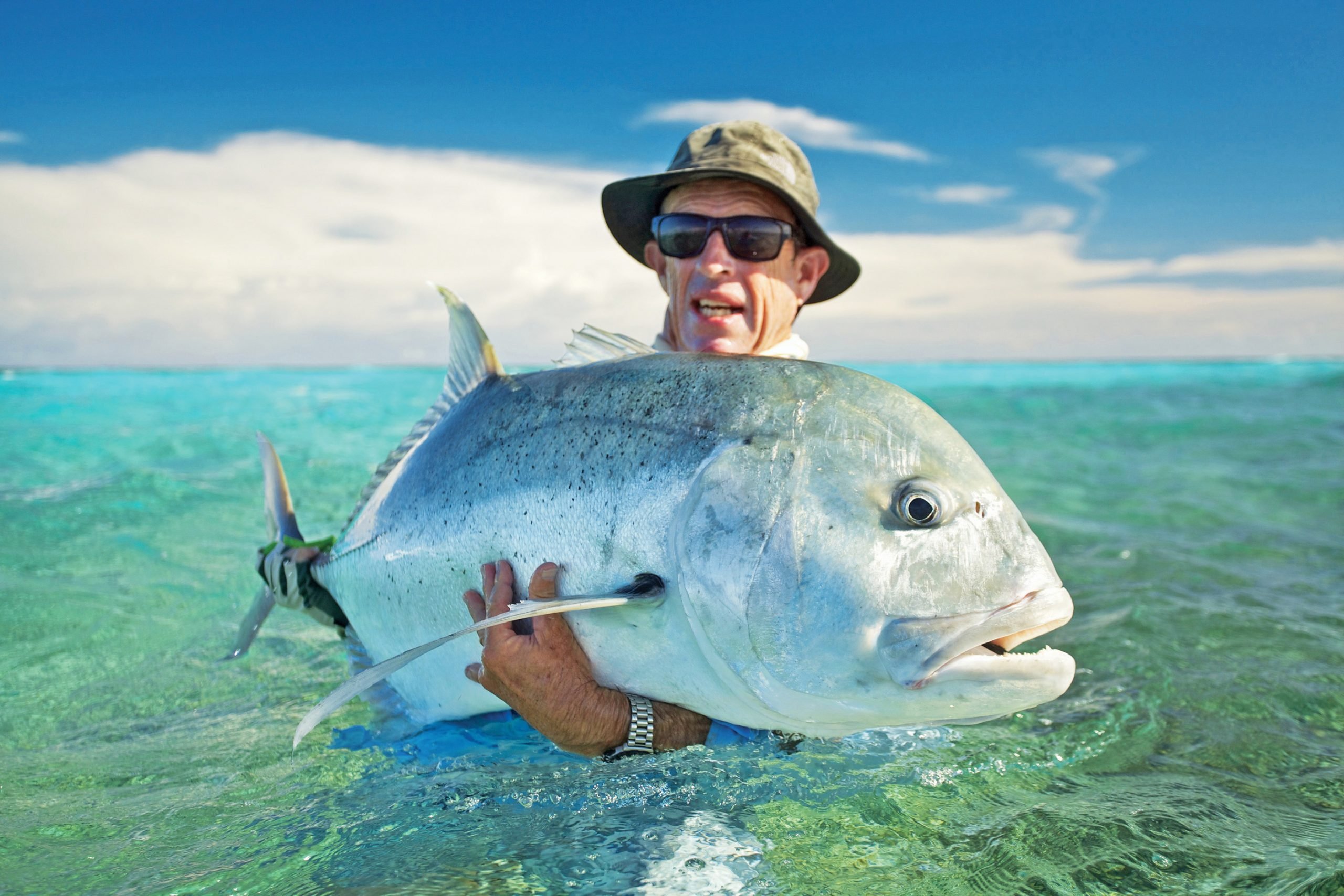

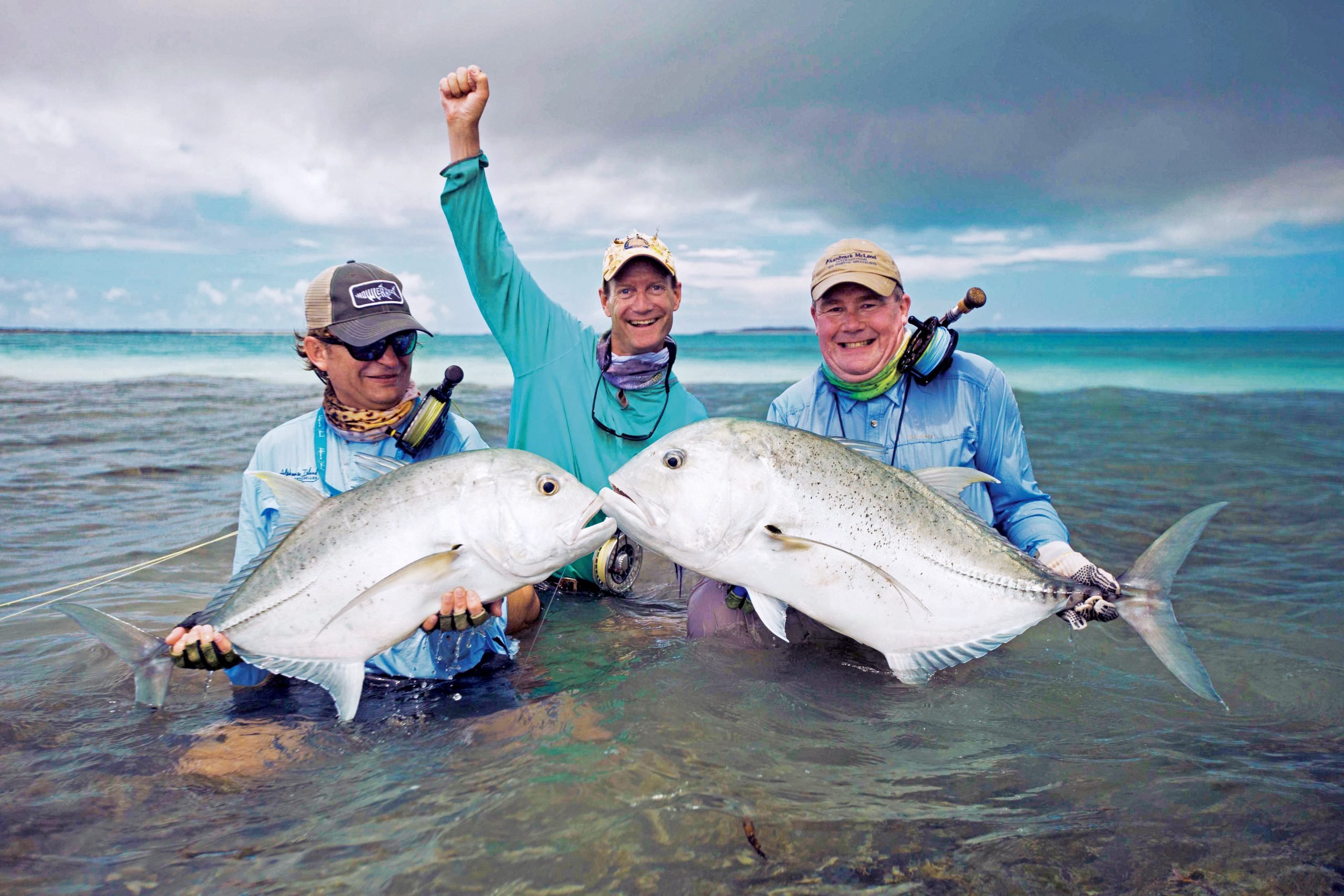

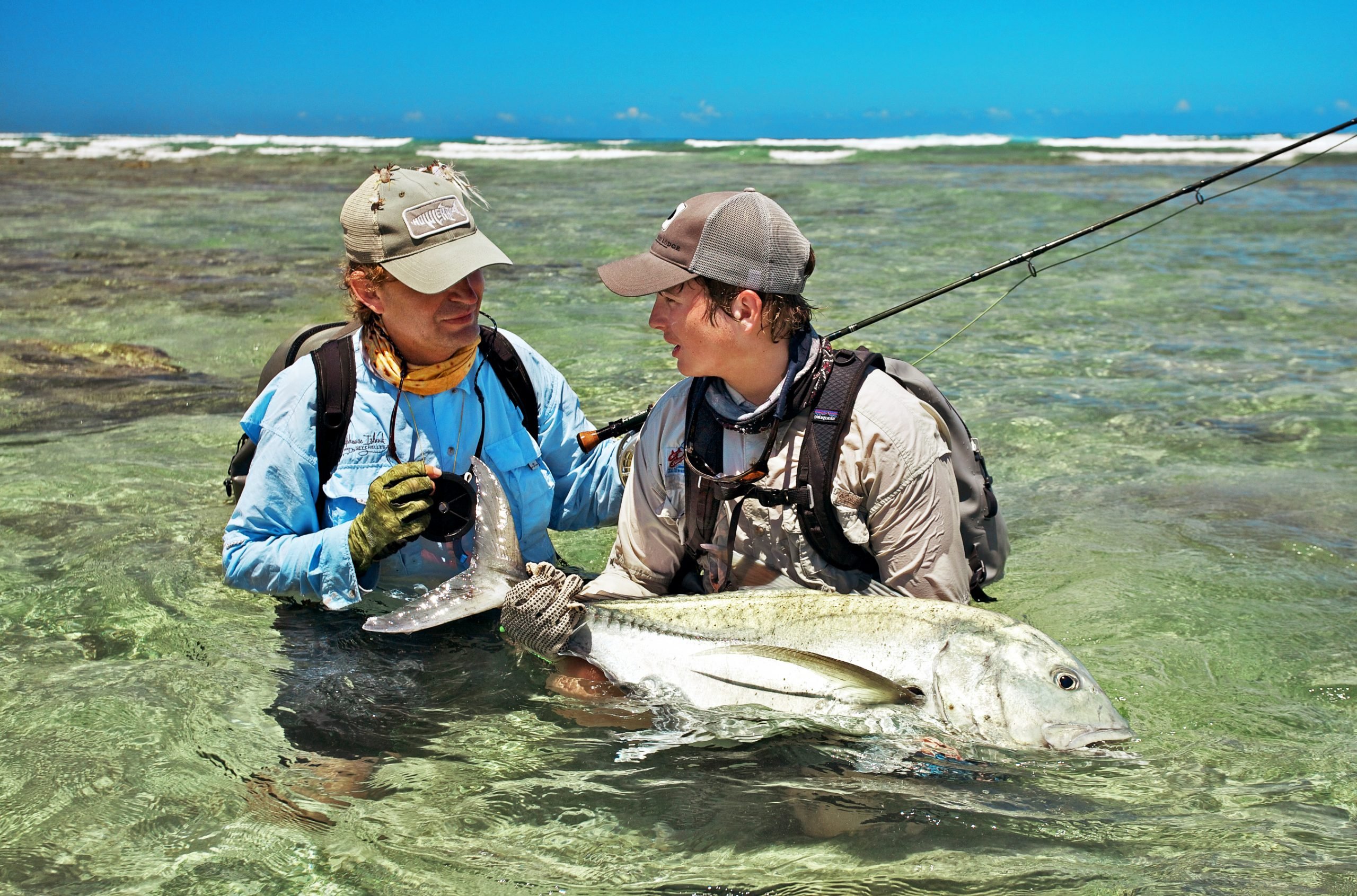

Playing GT’S on the Fly
At this point, you should already know how to catch Giant Trevally on the fly. After the first hookup, you will feel the raw power of a Giant Trevally. These fish will take long powerful runs; however, you need to break these runs as quickly as possible.
A simple rule to remember is the more line between you and the GT, the higher the percentage of losing that fish increases dramatically due to line cust on corals etc. Once the fish is roaring off, start to clamp up the drag, keep increasing the pressure until you feel like you cannot physically hold on to the rod any longer. Many people are scared to apply so much drag on these fish, but you will be surprised at how much you can use (on my reels which have had some abuse, I admit, I tighten them to the max and still increase the pressure by palming the spool as well).
In the very early days, we learned that you have to break the GT’s spirit, and you cannot hurt a GT playing it with your rod up in the air. A fly rod has no power to play a fish in the top half of the rod, so you need to make sure you are pulling so the rod is bent right down and through the handle.
Remember always to apply side strain and constantly keep changing sides. When the GT pulls hard to the right, you need to pull hard from the left; once the GT is more square on change angles and pull him from the opposite direction.
You need to gain line back as quick as possible, so pump and wind, no lifting up the rod, pull to the side, keeping the rod below 45 degrees and wind as the rod moves forward. This means you are giving the fish what we call the butt of the rod, which is where the power is. This combination of constant change of direction and powerful pulling back breaks a GT’s spirit. Before long, the GT will be turning on its side, for once you can get them on to their side, they calm down, and it is now when your guide can tail your fish.
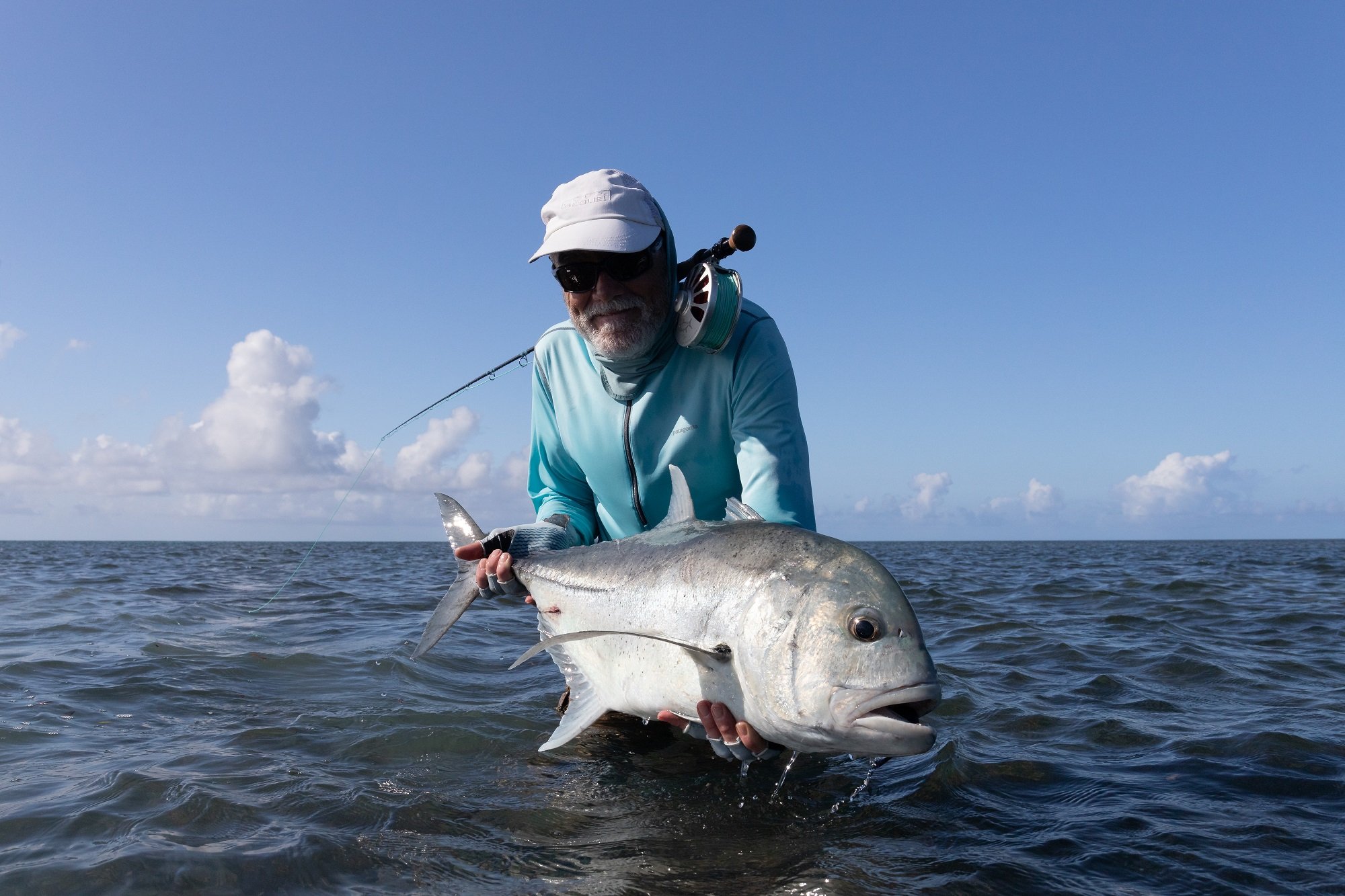

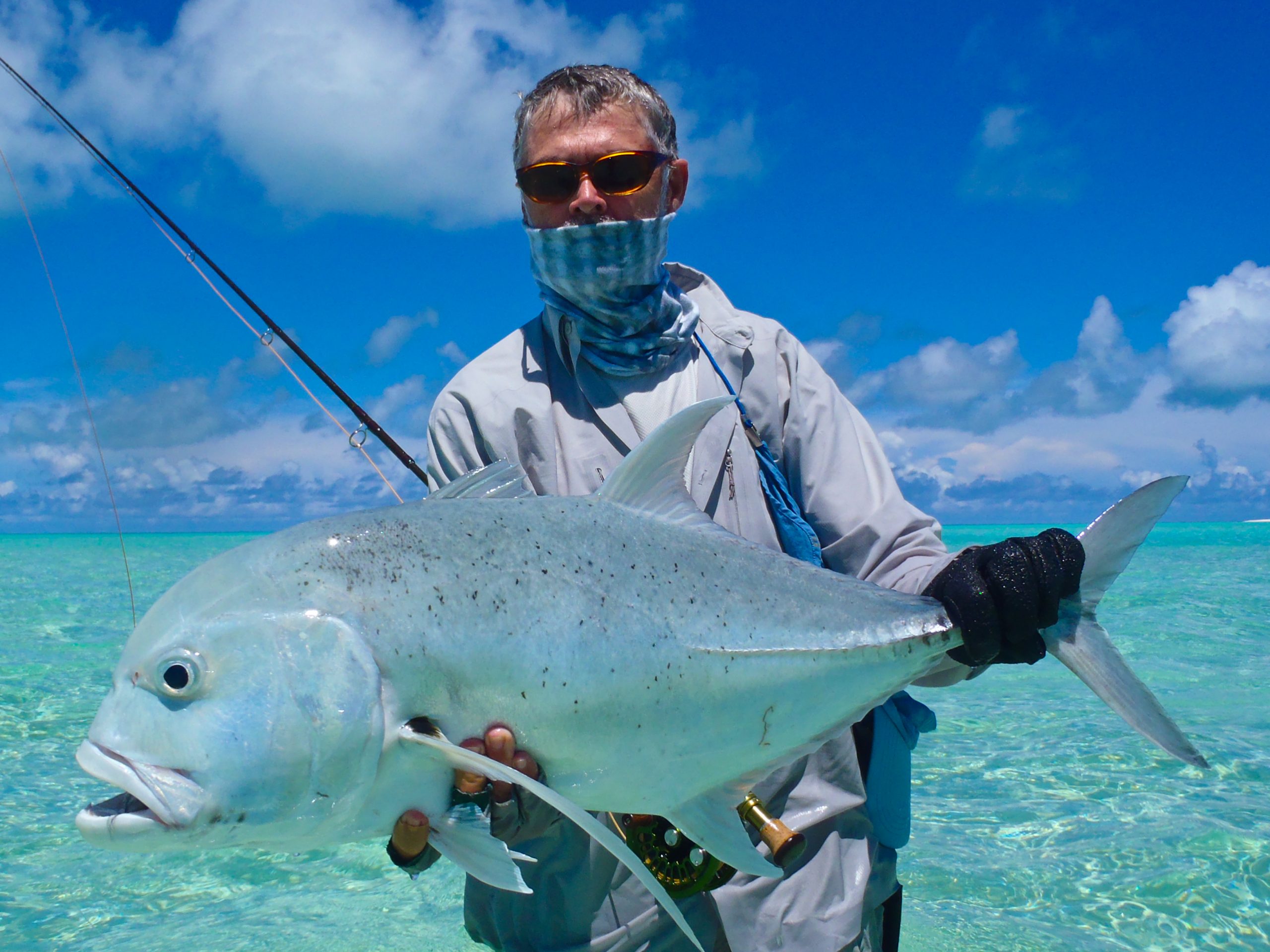

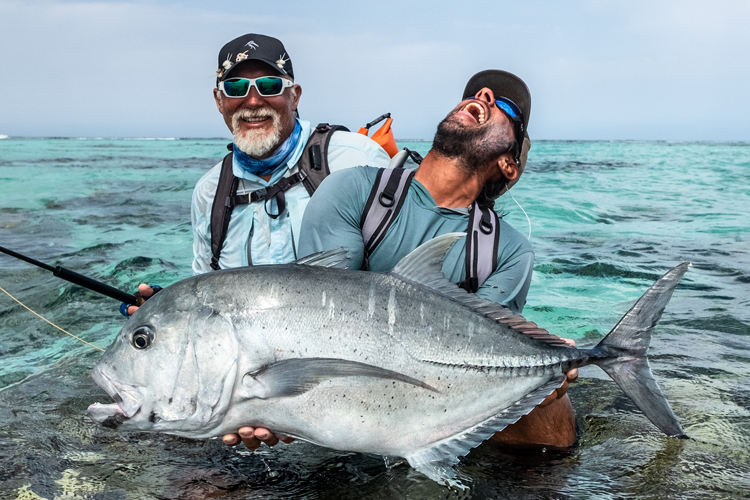

Enjoy Your Catch
Once your guide grabs the tail of your fish, you will be screaming, punching the air and wanting to hug everyone in the world, and so you should be. As mentioned right at the beginning, every landed GT, regardless of size, should be appreciated; for now, you know why you spent all that money on the tackle, travelled around the world, waded miles of saltwater flats and spent weeks practising your casting.
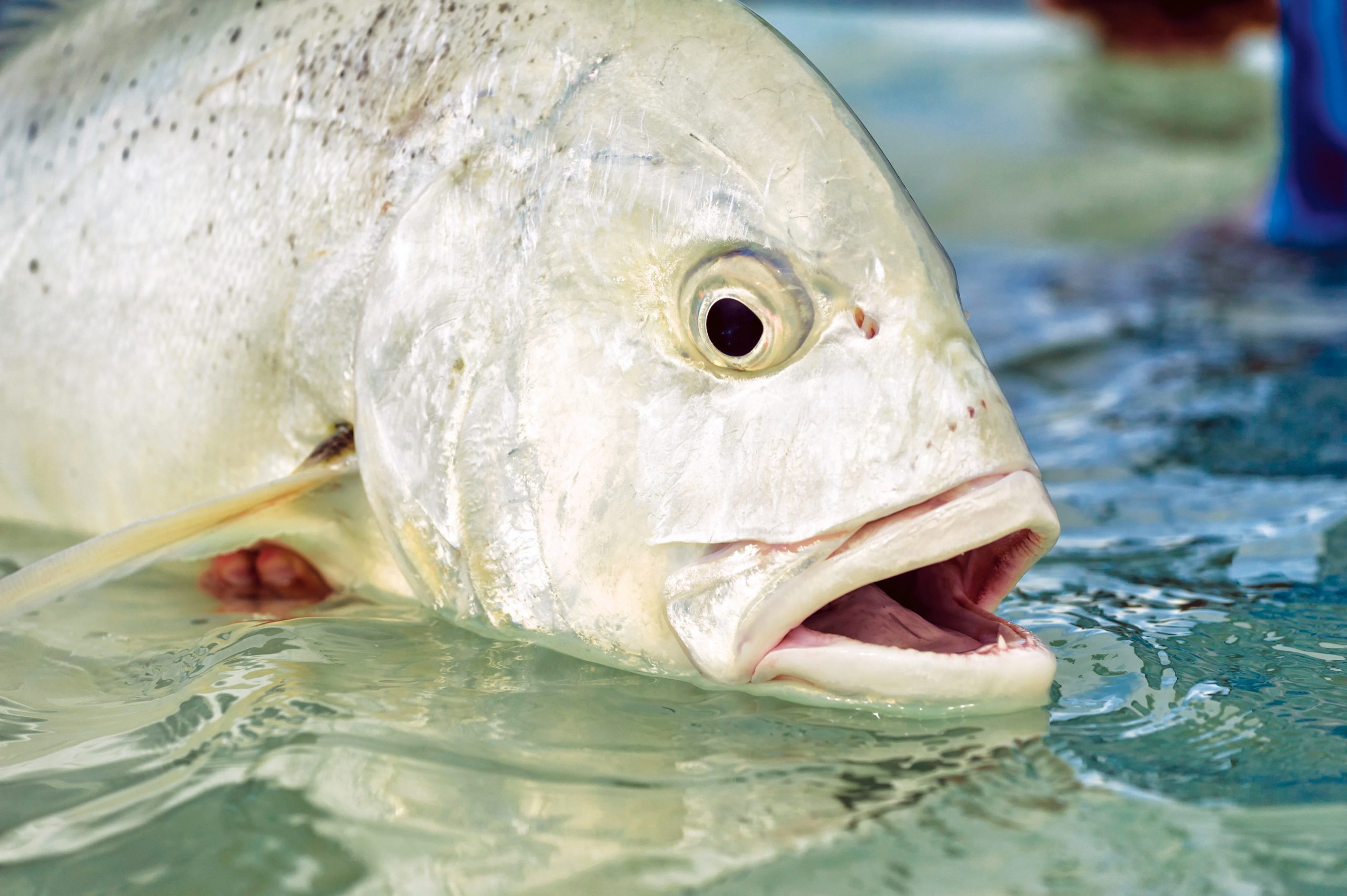

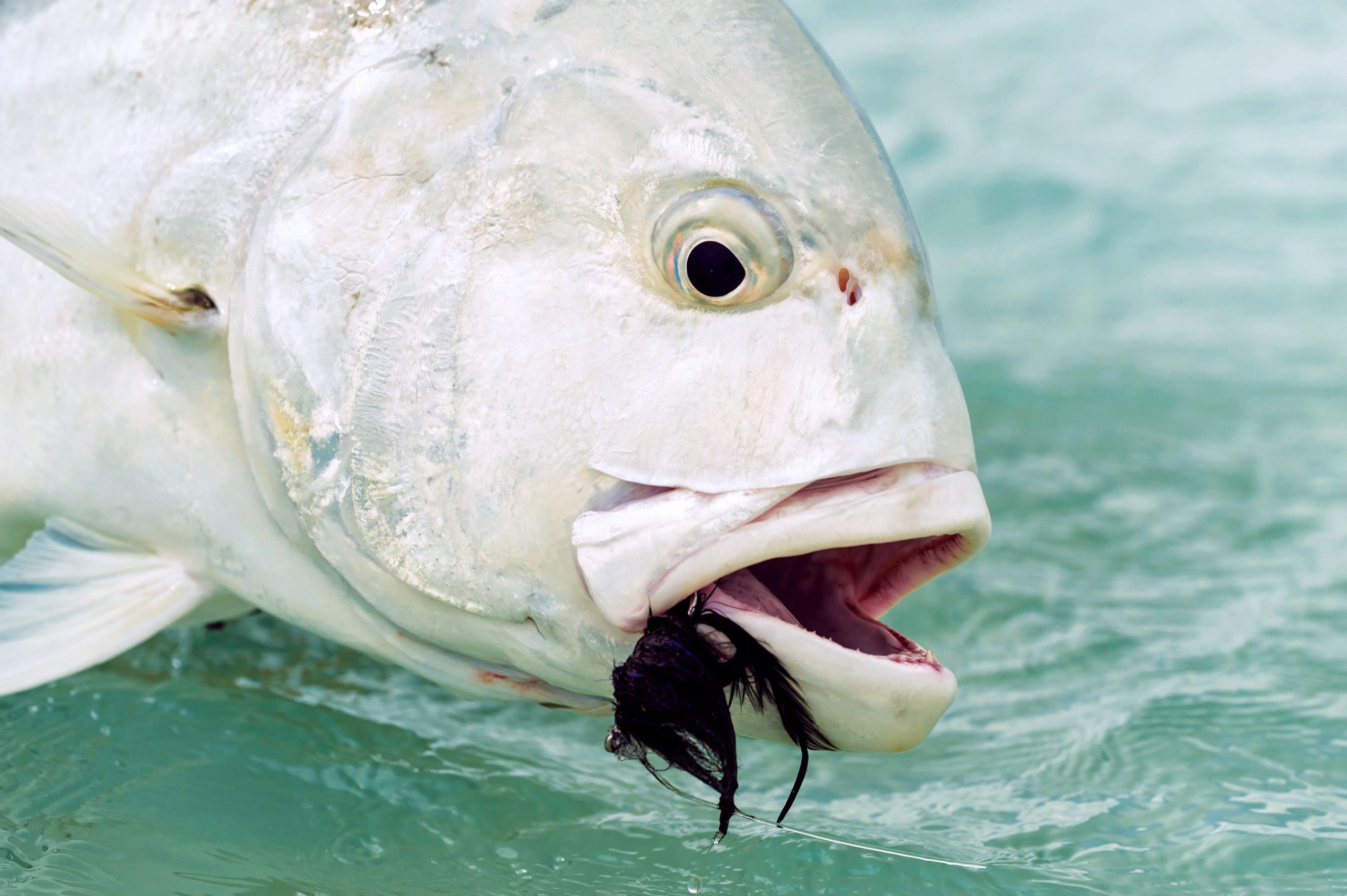

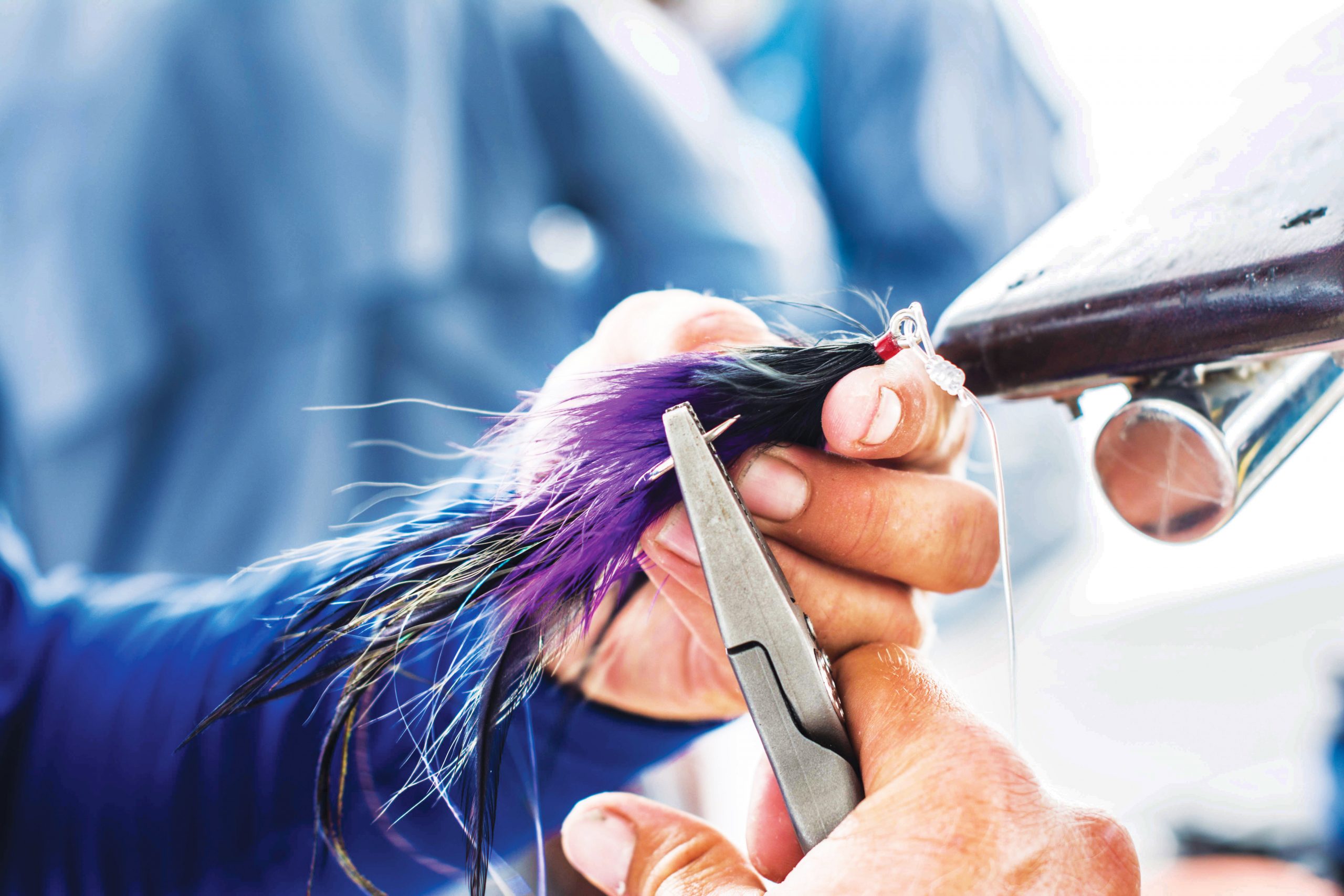

Welcome to the world of catching GT’s on the fly. We hope you took away some tips on how to catch Giant Trevally on the fly.
Tight Lines,
Peter
Contact us
You can learn more about how to catch Giant Trevally by watching my Fly Fishing For GT’s video on Youtube. This video shows how to cast, hook and land these amazing fish.
If you have ever wanted to catch GT’s on the fly, we host group trips every year. To learn more, you can contact me anytime in the office by calling 01603 407596 or by emailing peter@sportquestholidays.com.
